#Map 1924 canals
Explore tagged Tumblr posts
Text

Percy Fawcett poses in a 1911 photograph. Photograph Bridgman/ACI
The Man Who Died Searching For The Lost City of Z
In 1925, Explorer and Surveyor Percy Fawcett Disappeared In The Amazon Basin Looking For An Ancient Civilization. Although He Was Inspired By Questionable Sources, We Now Know If His Search was in Vain.
— By Jordi Canal-Soler | June 13, 2024
When the Spanish first ventured into the Amazon Basin in the 1540s, they recorded Indigenous accounts of a lost city of fantastic wealth that they called El Dorado (“the golden”). Over the centuries, many vain attempts were made to locate a lost civilization in the Amazon rainforest.
The last significant attempt to find such a culture was undertaken by British explorer Percy Fawcett. Between 1906 and 1924, Fawcett made seven expeditions across the Amazon Basin, concluding with his doomed quest to find the city he called Z. Fawcett was inspired by his extensive reading of historical sources, including a mysterious document known as Manuscript 512.
A man of extraordinary mental and physical stamina, Fawcett was working at a time when the Amazon region was still largely undocumented by Europeans who sought to explore its jungles and waterways, seeking ancient cities and riches. His disappearance during his search for Z in 1925, in the Mato Grosso region of Brazil, continues to intrigue writers and filmmakers.
Yearning To Explore
Percy Harrison Fawcett was born in 1867 in Torquay, Devon, the English county that had produced many famous explorers and mariners, including Francis Drake and Walter Raleigh.
The son of an aristocrat who had lost his fortune, Fawcett described his childhood as lacking in affection. At age 19, he was commissioned as a lieutenant in the Royal Artillery and sent to outposts of the British Empire.

This image was taken by Percy Fawcett on the upper Acre River in Bolivia, near the Brazil border, during an expedition. The region had suffered greatly at the hands of rubber exploiters. Royal Geographical Society/Getty Images
In 1901, Fawcett joined the Royal Geographical Society of London and traveled to Africa as a surveyor in the service of the British state, tasked with gathering military intelligence. In 1906, he was commissioned by the society to lead an expedition to the Amazon.
Arriving in South America was the moment his whole life changed. Setting out from La Paz to map the vast territory on the borderlands of Bolivia and Brazil, Fawcett often faced hostility from Indigenous peoples angered by rubber barons, who had invaded their lands to extract rubber for use in car and train manufacturing.
For nearly a decade he roamed the Amazon Basin, often the first European to record geographical features such as waterfalls. His writing gives a sense of the awe he experienced:


Fawcett’s Last Journey: After completing seven South American mapping expeditions for Britain’s Royal Geographical Society, Percy Fawcett returned in 1925 to search for the lost city of Z. He left from the same camp where his horse died on a previous expedition and was never heard from again. Source: David Grann, The Lost City of Z: A Tale of Deadly Obsession in the Amazon | NGM Staff
————Route of Fawcett’s 1925 Expedition | ++++++ Railroad
Above us rose the Ricardo Franco hills, flat topped and mysterious, their flanks scarred by deep quebradas [ravines]. They stood like a lost world, forested to their tops, and the imagination could picture the last vestiges of an age long vanished.
The outbreak of World War I interrupted this rich period of exploration, forcing him to return to Europe. Although in his 50s, Fawcett was in peak physical condition, and he proved to be an outstanding soldier.
A Mysterious Manuscript
Fawcett could not shake off the allure of South America, however. So, when the war ended, he returned to Brazil, where he would pursue an idea that led him to his last great adventures and, ultimately, his mysterious death.
Although Fawcett often relied on racist tropes and ideas when he wrote of Brazil’s Indigenous peoples, he also made great efforts to understand their customs and languages.
He lamented the effects of colonialist greed on these societies and became convinced that Spanish and Portuguese accounts from the 16th and 17th centuries of complex civilizations in the rainforest may have had merit. Such accounts mention “very large settlements” as well as “fine roadways in the interior.”
One document in particular fascinated Fawcett. Known as Manuscript 512 and written in Portuguese, it is purportedly an account by adventurers and fortune hunters. In 1753, in search of precious metals, the adventurers found a ruined city boasting monumental buildings, roads, and a plaza, in “each corner of which is a spire, in the style of the Romans.”

Mystery Manuscript! The document that partly inspired Fawcett’s search for Z is kept in Brazil’s National Library. Manuscript 512 is considered a forgery by some scholars, although Fawcett was not the only one who believed it was authentic. Explorer Richard Burton was intrigued by it during his travels in Brazil in the 1860s. National Library, Brazil
Scholars are divided about the manuscript’s authenticity. Skeptics consider it a forgery. Brazil achieved independence from Portugal in 1825. It would have been useful for a new, insecure republic to “discover” a document that described ancient civilizations in its territory—akin to the great Maya sites in Central America. Many at the time, however, accepted the manuscript’s authenticity, including Fawcett, already convinced that early accounts of complex civilizations in the rainforest were accurate. He became obsessed with finding such a place.
In Search of Z
Although Fawcett was inspired by Manuscript 512’s claims, he never intended to find the city it described. The settlement in that document lies, supposedly, in Brazil’s northeast. Citing other sources (which he did not name), Fawcett became convinced that a lost civilization existed in the wild, central-western region of Mato Grosso. He named the city Z.
In April 1925, Fawcett set out from Cuiabá to find it, accompanied by his eldest son, Jack, and his son’s best friend, Raleigh Rimell. The last news from them was in a letter Fawcett sent to his wife: “We shall disappear from civilization until next year. Imagine us ... in forests so far untrodden by civilised man.”
And then they really did disappear. Were they killed by animals or people? Several expeditions were launched in an attempt to clarify what happened, including one headed by Peter Fleming, brother of the James Bond creator Ian Fleming. Many of these ventures also ended in tragedy. And none shed any light on what happened to Fawcett.
In 1952, anthropologist Orlando Villas-Bôas announced he had found the bones of the explorer and that Kalapalo Indians had confessed to killing him. Later forensic analysis showed the remains did not belong to Fawcett.

For a decade, Fawcett roamed the Amazon Basin. His writings, which his son compiled in this posthumous 1953 book, give a sense of the awe he experienced.
Fawcett’s story has had an enduring cultural impact. He is one of the inspirations for the character Indiana Jones. (The Walt Disney Company is a majority owner of National Geographic Media.) The English explorer was also the subject of David Grann’s The Lost City of Z: A Tale of Deadly Obsession in the Amazon, the basis for a 2016 feature film. In his book, Grann quotes Kalapalo Indians, who insist they had not killed Fawcett. They had seen the smoke from Fawcett’s camp for a few days until it stopped. They say he likely died at the hands of “hostile” people in territory to the east.
Although the mystery of his last days may never be fully resolved, Fawcett’s quest for a lost city may be at an end. In the decades since his disappearance, exploration of northeastern Mato Grosso has uncovered the remains of large urban settlements, now located in Xingu Indigenous Park. Named Kuhikugu, the complex includes remnants of streets, bridges, and large squares. Modern lidar scans further suggest that between 1,500 and 400 years ago, this part of the Amazon was indeed the site of a large settlement. While Z’s exact identity and location are still a mystery, Fawcett’s hunch about a hidden ancient city in the region seems to have been correct.
#Lost City#Exploration#Explorers#Mysteries#Rainforest#Treasure Hunting#History Magazine#Percy Fawcett#Lost City of Z#Disappearance | 1925 | Explorer 🧭 | Surveyor | Percy Fawcett#Amazon Basin#Ancient Civilization#Mysterious Manuscript#In Search of Z
2 notes
·
View notes
Text
My Prediction: Grace is Alive
Unpopular opinion here I know. I know SK said she was dead and she may very well be but till I see REAL ghost Grace, her funeral, or a flashback to her dead body then nope I won’t believe it.
I didn’t actually believe she was alive till after the 5th season. But down below I’ll list the signs I’ve seen throughout the show that I think point to her not really being dead.
Grace is all over season 5 but the signs I’ve seen that point to her not being dead are in episode 4 and 5.
For starters the swans represent Grace this season as told in an article from Den of Geek. Which is a big theme for episode 4.
So episode 4 is called The Loop and there are quite of bit of things that are repeating in this episode from previous seasons. Actually I’d say this whole season feels like a loop. But anyways for the Grace clues...
We have only 2 scenes this season in the Garrison snug which are both in this episode back to back. This is also where the swans are present. So we are to be thinking of Grace during these scenes.
The first scene is with Mrs.Conners, she is there because her 3 songbirds (goldfinch’s) were killed by her husband. Now I believe the songbird represents Grace along with the swan. As she’s already been linked to the blackbird in s3 and s4 which is also a songbird. Plus one definition of songbird is: a female singer, which she is. When Mrs.Conner says “their singing was the only pretty thing in my life” it focuses on Tommy and the swans to the side of him. I’m sure he thinks the same of Grace and her singing.
Now I also think songbirds represent the Shelby’s in general or at least Goldfinch’s do. Mosley talks of Tommy being a songbird and his singing beautifully in the house and in that same scene he calls Ada a finch. Then when Tommy tells Mrs.Conner Arthur will go get her 3 new Goldfinch’s she says she’ll name them Tommy, Arthur, and Finn. So that’s all 4 siblings being linked to a finch.
Mrs.Conner leaves and here comes Brilliant Chang. Now don’t forget this happens in the room with the swans that represent Grace.
Shows Chang sitting down right where the swan is unlike Mrs.Conners. We really didn’t see the swan behind her because it wasn’t important. But I believe we saw Chang sit right where the swan was because we are to link him specifically to Grace. Just check out this dialogue:
Chang: My name is Brilliant Chang
Arthur: Brilliant Chang is dead
Chang: Perhaps. Sometimes, I wonder... Is this heaven? Doesn’t smell like heaven. So I would say I have survived.
Now that might not seem like a big deal but the real Brilliant Chang got deported in 1924 and was never thought to be dead (the year here is 1929). So they essentially just made this scenario up for the show and they decide to do it in the room that has Grace motif’s all over it. Yeah...
After Arthur thinks Finn has been shot by Chang’s accomplice he pulls a gun on him. Watch Chang stare down Arthur, it’s exactly like Grace’s with Kimber and IRA man she shot.
After this Chang puts the “purest” opium on the table. Pure truth he calls it. Which the opium also represents Grace, as you know that’s what Tommy drinks to hallucinate her and quite literally later as she takes the opium’s place on the barge in Tommy’s hallucination.
When Chang gives the Opium to Tommy as a gift, Tommy’s line is “I’ll throw it in the canal” which is just like his line to Grace in 1.06 “One day we’ll throw this gun in the canal”.
So now we have 4 things that represent Grace. The songbird, Swans, Chang, and Opium. Those will be important later.
The Next big scene we have is when Tommy hallucinates Grace in his office after Mosley leaves and she’s blaming him for her death. He can’t even look at her in this scene. It goes straight from this scene to him standing on bridge looking down, He see’s the January with Grace half covered in the coals (she’s in the spot the opium would be).
He runs to Ada to tell her about his vision (hallucination) of Grace even though it’s 2 AM. He tells Ada “Grace was there. But she was still alive. The name of the barge was the January”. Now this sticks out to me because he says she was still alive. It made no sense to me while this is the hallucination he says this about. He’s been talking to her and seeing her in other places but doesn’t say anything like that. He knows she’s not real so what gives. Then I read in the article above they originally had a swan that swimming in front of the barge but decided to cut it. So this scene was supposed to be the one you linked the swan imagery to Grace but since they cut it most people won’t know that the swan represents her through this series.
So here we have a swan in front of the barge that has Grace on it in place of the opium which Chang called “pure truth” and Tommy saying she was alive. Also, she’s not on just any barge but the January which is the boat Tommy had his healing journey on in s2. Hmm...He even says at one point to Ada “there is a part me that is unfamiliar to myself and I keep finding myself there and only the January can get me away”...Is that the shows way of saying that Grace being alive would help heal him like the January did in s2?
Now I agree with Ada that the black barge signals guilt for him too especially with Grace inside it. Even though he won’t admit it to anyone, we all know he feels guilty about her death.
Now about the Swan Lake Ballet. Polly tells Michael that Tommy want to impress someone which is Mosley this time but who is the other person he was constantly trying to impress. It’s the shows way of reminding you of her without saying her name.
When we get to the Lizzie’s party the first scene is with Michael and Gina Grey (Tommy and Grace lite lol). Tommy and Grace’s Secret Portrait are featured in most of this scene. They even focus on it at the end of their scene. Maybe the horse was named Grace’s Secret because her secret is she’s alive. The paintings are supposed to have a storyline of their own but we’ve never actually seen it. That portrait is the portrait we’ve seen every season (or a version of it) so it’s important. SK already had the series mapped out by s2 just hadn’t written it yet so it wouldn’t surprise me.
Now another thing that caught my attention, when Gina is telling Michael he’ll be replacing Tommy and he asks where Tommy will be she replies “where he wants to go to most”. We all think of that as death but let’s be honest, it’s with Grace. That’s what tips him over the edge every time to actually try to commit suicide (to be with her). So if she’s dead that’s where but if she’s not then it’s wherever she is.
On to another scene, in the scene between Mosley and Tommy having a brandy before the play we see pictures on the table with the liquor. There’s quite a few on there but Grace’s is the lightest one on the table and the one our eyes are drawn to. It’s a way to remind us of her again and look it’s her undercover picture.
Now we have the Swan Lake ballet. @korinthya has an exceptional analysis on this and what it means for the Peaky universe. So I’d go check it out if you’re interested.
We only see the swan dancing and not much of the story but as she’s dancing, Linda rolls up in her car and when she gets out she’s wearing a dress with songbirds on it!
She gets shot the exact same time as the Swan does. It looks like both Linda and the swan are dead (just Like Grace) but at the last second it makes a point to show the swan open her eyes. No need to do that unless it was important to the narrative because there is no other scene connected to that shot. Also, normally the swan dies by drowning not getting shot, so they changed that specifically to mirror Grace.
Once the next episode starts (ep5) we see that Linda has not died (the songbird lives). She was just shot in the arm, the same side as Grace (which is funny because Aberama and Finn were shot in the almost exact same spots this season and lived too). Now this scene could be a retelling of what sort of happened with Grace, not exact of course. Think about it, this whole season has been a loop of events. Working with the Chinese, the white flag truce, the bartender is a spy, there is a singer in the bar, Tommy shooting a horse, him doing his arm gesture in 5x01 like he did 3x01 with the no f’ fighting scene, ect. There’s so much more if you look.
So lets look at the key things from this scene with Linda and see what could have happened after Grace got shot.. Tommy is pulling Arthur away and telling him to go outside till it’s done (Linda getting the bullet out), which if you remember in 4x01 he told Polly to let the nurses and doctors do their job too. So it’s not out of the realm of impossibility that he let the doctors work on Grace and him not be in the room (she was still moving by the end of 3x02 so I don’t doubt she was alive when an ambulance got there). Tommy also says the bullet is still in there, it’s above the bone which could also be what happened to Grace. Don’t forget it looks like she got shot right on her collarbone not under it. This is part is important and can be a big clue as to how someone could pass her off as dead, Tommy sends Arthur out to get some Opium for Linda but Polly has some of her own and so Tommy gives it to Linda while Arthur is still out of the room. She passes out and then Arthur comes in the room and thinks she’s dead. He doesn’t even realize she’s alive until Tommy tells him that she’s ok and he gave her something to knock her out.
That could easily be what happened to Grace. Tommy might have let the doctors do their work, someone slipped her something (maybe section D, they did say they can get to anyone anywhere and they were there at the party) and when Tommy came back in it looked like she was dead. He might not have been able to handle looking at her like that and left. Remember in his hallucination in his office where she is holding the stone, bleeding and accusing him of her death he can’t look at her once. It might have been the same way in the hospital.
We also have another loop in this scene. Arthur is saying that Polly should have let him take the bullet (the original bullet was meant for Arthur but Polly stepped in and saved him) and it’s a repeat of the original bullet that Grace took was meant for Tommy. So the brothers were supposed to take a bullet but nope the wife ended up getting it. It doesn’t stop there during this scene either. We have another loop. Polly tells Arthur, Aberama wants him as his best man at their wedding just like Tommy wanted him as his best man at his wedding in 3x01.
Seriously just watch this season over and see how many loops there are. There is so many it’s unreal.
In the next scene with Linda and Arthur, she leaves him. which is essentially what Grace did with Tommy (voluntary or not it happened).
Then there is Ben Younger which is also some of a loop. He’s a British intelligence officer like Grace was. He’s having threats made to him by Section D because of Tommy (don’t forget they threatened Tommy’s family). He even brings up Section D’s history with Tommy. Tommy tells Ada “he pushed him to report on the Fascists” which is a loop of him telling the Gypsy lady “he pushed some people to far” (about the Italians). Saying he is guilty of both their death’s. He tells Ada that Section D or the intelligence branch had him killed (the loop here is that is who could have took Grace). Then some other things that connect younger to Grace also, Tommy said his death would go down as “an IRA assassination of a British Military Officer” which is what happened to Grace’s father. Then we see neither Grace’s or Ben’s dead bodies or funerals. Plenty of loops here. I do think Ben is dead though. The loop with Grace for him is the connections to section D and maybe the excuse to as how she died. I bet they didn’t say she was shot by an Italian in revenge. The ladies at the institute know of her death and aren’t afraid of Tommy so I bet they had a good cover.
Back to Chang, in his next scene we have talk of the police, Irish, and Opium. Which can be associated with Grace. He also talks about the Uncles being mad. That is the part that caught my attention. It was just a quick one liner that didn’t make much sense but remember the only family member we seen of Grace is her uncle and he was not happy about the marriage.
Arthur then says “F’ your uncles. And your aunts, your cousins, all of them Right?” which reminds me of Tatiana’s line in s3 “Brothers gave sisters, aunts gave uncles, fathers gave daughter and servants”. The deliveries were identical. So another loop.
Now I Think that’s most of the symbolism in S5.
Before I end this post I want to talk about SK saying Grace is dead. He’s probably not lying but it doesn’t have to mean dead like we think. Look at both Alfie in season 5 and Polly in s4, both say they died (when they had an attempt on their life) but are actually still alive. I mean even Aberama calls Polly a ghost in their kissing scene in s4. So I could see the same thing happening to Grace. She is dead like them but also still alive.
I mean isn’t that Tommy’s thing? He died in the war but he’s still here. Aren’t him and Grace the same but also mirrors? So who she was when she shot could very well be dead and a different Grace (maybe even different name if undercover) emerged and SK could still say she’s dead because hey guess what in context of the show she is, just like Polly, Alfie, Tommy, Danny Whizzbang(was), Chang, and Arthur (his fake out in s4).
If she does come back I don’t see it happening until maybe 11 years have passed. 11 seems to be the special number between Tommy and her. When Tommy has his soldiers minute in s1 the time on the watch is 11. Then before they sleep together in s2 Grace tells Tommy “it’s too late” and he says “Grace it’s 11:00″ and her replay is no “no I mean it’s too late”. So it’s not about time at all. I could see her coming back 11 years later and her telling Tommy it’s too late.
Now while I don’t think she is dead (final) after watching season 5 and going back through the seasons if I ever do see real ghostGrace I will hang up that theory. But the more I pay attention the more I see that something is amiss.
Ok, I’m done now. I may do a post about s3 and s4 and the signs there but this post is long enough as it is.
61 notes
·
View notes
Text
“VIOLENCE WILL NOT BRING CHANGE.”
That’s what Biden said in his latest advert.
Are we kidding ourselves here? Seriously? It’s the AMERICAN WAY! Let’s review a little history...

1619: SLAVERY BEGINS in AMERICA
American Revolutionary War (1775–1783)
Cherokee–American wars (1776–1795) USA v. Native Americans
Northwest Indian War (1785–1793) USA v. Native Americans
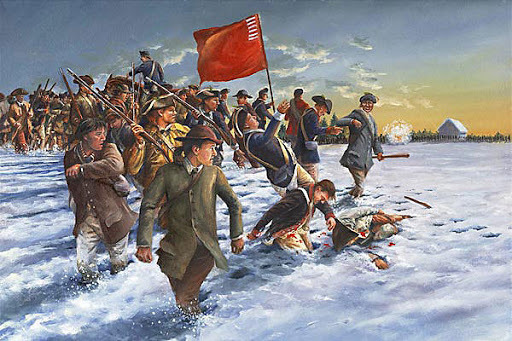
Shays' Rebellion (1786–1787) USA v. Citizens During Debt Crisis
Whiskey Rebellion (1791–1794) USA v. Citizens over TAXES
Quasi-War (1798–1800) Naval Pissing Match- USA v. France
Fries Rebellion (1799–1800) USA . PA Dutch Farmers over TAXES
First Barbary War (1801–1805) USA & Sweden v. N. Africa (Pirates)
German Coast Uprising (1811) Slave Rebellion in New Orleans v. USA
Tecumseh's War (1811) Native Annihilation.
War of 1812 (1812–1815) USA v. Britain over UK’s seizure of ships and men
Creek War (1813–1814) USA v. Alabama Native Americans
Second Barbary War (1815) Again.
First Seminole War (1817–1818) USA v. Florida Native Americans
Texas–Indian Wars (1820–1875) USA v. Texas Natives & Spain/Mexico
Arikara War (1823) USA v. Sioux Native Americans
Aegean Sea Anti-Piracy Operations of the United States (1825–1828)
Winnebago War (1827) USA v. Wisconsin Native Americans
First Sumatran expedition (1832) USA v. Indonesia
Black Hawk War (1832) USA v. Ill & Mich Native Americans
Texas Revolution (1835–1836) USA v. Mexico to steal Tex-ass
Second Seminole War (1835–1842) USA v. Native Americans in Florida
Second Sumatran expedition (1838)
Aroostook War (1838) USA v. Britain over N. Brunswick & Maine Border
Ivory Coast expedition (1842) USA v. Bereby, W. Africa against Slavers
Mexican–American War (1846–1848) USA v. Mexico to seize TX, NM & CA
Cayuse War (1847–1855) USA v. Oregon Native Americans (Annihilation)
Apache Wars (1851–1900) USA v. Apache Native Americans in s.west

Bleeding Kansas (1854–1861) USA v. USA Kansas & Missouri Conservative PRO-Slavery versus Abolitionist/Progressive ANTI-Slavery in new territories.
Puget Sound War (1855–1856) USA v. coastal Wash. State Native Americans
First Fiji expedition (1855) USA v. Fiji over the islanders not wanting rich American fucks there anymore. We did away with that by force, by Harry!
Rogue River Wars (1855–1856) USA v. Oregon Native Americans
Third Seminole War (1855–1858) USA purges last of Florida Natives
Yakima War (1855–1858) USA v. Washington Native Americans
Second Opium War (1856–1859) USA, Britain & France v. China over forcing the Chinese to buy opium to keep them compliant
Utah War (1857–1858) USA v. The F’n MORMONS This was the Waco Tex-Ass of its time.
Navajo Wars USA v. New Mexico Native Americans (Long Walk)
Second Fiji expedition (1859) USA v. Fiji. We told them once...
John Brown's Raid on Harpers Ferry (1859) USA v. USA, Prelude to Civil War
First and Second Cortina War (1859–1861) USA (Then CSA) v. Mexico in TX
Paiute War (1860) USA v. Nevada Native Americans
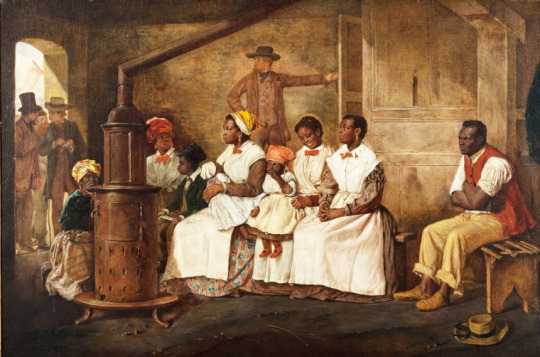
American Civil War (1861–1865) USA v. CSA
Yavapai Wars (1861–1875) USA v. AZ Native Americans
Dakota War of 1862 (1862) USA v. Minnesota & Dakota Native Americans
Colorado War (1863–1865) USA v. Colorado, Wyoming & Nebraska Natives
Shimonoseki War (1863–1864) UK, USA, France, Dutch v. Japan over straight between Japan’s own islands.
Snake War (1864–1868) USA v. Native Americans in Oregon, Nevada, Idaho & California
Powder River War (1865) USA v. Native Americans in Montana & Dakota
Red Cloud's War (1866–1868) USA v. Native Americans in Wyoming & Montana
Formosa expedition (1867) USA v. Taiwan Natives in response to massacre of crew of wrecked USS Rover, a small bark.
Comanche Campaign (1867–1875) USA v. Native Americans in western states/territories
Korea expedition (1871) USA v. Korea in retaliation for being shot at because they hated us.
Modoc War (1872–1873) USA v. Native Americans in N. Cali & Oregon.
Red River War (1874–1875) USA v. Native Americans in S.W.
Las Cuevas War (1875) USA/TX v. Mexican Raiders
Great Sioux War of 1876 (1876–1877) USA v. Native Americans in S.W.
Buffalo Hunters' War (1876–1877) USA v. Native Americans in TX & OK
Nez Perce War (1877) USA v. Native Americans in Oregon, Idaho, Wyoming & Montana
Bannock War (1878) USA v. Native Americans in Oregon, Idaho & Wyoming
Cheyenne War (1878–1879) USA v. Native Americans in Oklahoma, Kansas, Nebraska, S. Dakota and Montana
Sheepeater Indian War (1879) USA v. Native Americans in Idaho
Victorio's War (1879–1881) USA/Mexico v. Apache in Mexico
White River War (1879–1880) USA v. Native Americans in Colorado
Pine Ridge Campaign (1890–1891) USA v. Native Americans in S. Dakota
Garza Revolution (1891–1893) USA & Mexico v. Mexican Revolutionaries
Yaqui Wars (1896–1918) USA/Mexico v. Native Americans in Mexico & AZ
Second Samoan Civil War (1898–1899) USA v. Germany over Samoa Control because screw the natives already living there.
Spanish–American War (1898) USA v. Spain- when the US wanted to bugger Spain and used the likely accidental destruction of the USS Maine (”Remember the Maine!”) in Havana Harbor as an excuse for war.
Philippine–American War (1899–1902) USA v. Philippines because we won you from Spain in the last war; screw you if you’re a native on the island.
Moro Rebellion (1899–1913) USA v. Philippines because while we’re here, we’ll meddle in your politics too.
Boxer Rebellion (1899–1901) USA v. China because they wanted those douchebag imperialists, foreigners and goddamn Christians to simply fuck the hell off back to where they came from because they suck.
Crazy Snake Rebellion (1909) USA v. OK Native Americans because Americans just LOVE betraying treaties and killing the native population.
Border War (1910–1919) USA v. Mexico & Germany because it’s more fun to play with guns and kill one another rather than sit at a table with a map and come to an amicable agreement.
Negro Rebellion (1912) USA v. Cuba (under US control from war with Spain) where we literally went in and slaughtered Afro-Cubans for wanting freedom. (Part of the Banana Wars)
Occupation of Nicaragua (1912–1933) USA v. Nicaragua where the US seized land and occupied it because a canal was going to be built and never was. Oops. (Part of the Banana Wars)
Bluff War (1914–1915) USA v. Native Americans in Utah and Colorado. Again. Why should the last generation have all the fun, right?
Occupation of Veracruz (1914) USA v. Mexico. Because fuck those Mexicans, right?
Occupation of Haiti (1915–1934) USA v. Haiti because why not? We own you now. (Part of the Banana Wars)
Occupation of the Dominican Republic (1916–1924) USA v. D.R. because we may as well own you too while we’re in the area.
World War I (1917–1918)
USA arriving very late in the “War to End All Wars”. “Thanks for nothing,” said the allies, “But please; take all the credit.”
Russian Civil War (1918–1920) USA & Europe v. Bolshevik Russia which didn’t end well for the USA & allies. We totally lost that one.
Last Indian Uprising (1923) USA v. Native Americans in Utah because we’d rather have Mormons than the Ute and the Paiute tribes.
World War II (1939–1945)
USA fights Japan covertly in the Pacific, aiding China against Japanese aggression. USA assists Britain and occupied Europe against the FASCIST regimes of Hitler’s Nazis and Mussolini in Italy and fucks off until the Attack of Pearl Harbor in 1941. “Oh, THIS shit again?” asks Europe. “Showing up late YET AGAIN, but sure; hey, USA, take all the credit yet again. Seriously, fuck you guys. Thanks for the assist, but we could have saved millions of lives of you’d gotten of your fat asses YEARS ago!”
Korean War (1950–1953) USA v. N. Korea in a proxy war with the USSR and China because fuck those commies, right? We won, even though they kicked our asses and a formal treaty was NEVER signed so technically the war is actually STILL ON.
Laotian Civil War (1953–1975) USA v. Laos and those commie scumbags. Yep. We don’t talk about this one because we LOST.
Lebanon Crisis (1958) USA v. Lebanon, Beirut, because we like Christians and fuck those Muslim twats, right? (God, we’re not a good people in the US...)
Bay of Pigs Invasion (1961) USA & Cuban Revolutionaries v. Cuban Government because fuck the commies. Maybe if we help, we’ll own Cuba again... Oops. Nope. Totally fucked that up.
Simba rebellion, Operation Dragon Rouge (1964) USA and EU Allies v. S.E. Asia in amounted to a total clusterfuck that dissolved Vietnam and was a precursor there as well as other areas. It helped the rise of dictators all throughout the region. Khmer Rouge anyone?
Vietnam War (1955–1975) USA, S. Vietnam, Australia, New Zealand etc. v. China-backed, USSR backed N. Vietnam. The Imperialist WEST v. the Communist EAST. That ended in a shit-show for the West like all proxy wars in southeast Asia do.
Communist insurgency in Thailand (1965–1983) USA/Local allies v. China/ally backed communist rebels. Pretty much a draw that petered out and Communism didn’t really stick... sort of.
Korean DMZ Conflict (1966–1969) USA v. N. Korea because they attempted to convince the S. Koreans to rise up and join the North, throwing out the WEST. No dice for them.
Dominican Civil War (1965–1966) USA v. Dom. Republic insurgents to restore Dem elected government. It worked so well that we would decide never to really do that sort of thing again when doing it the opposite way gets us more money.
Insurgency in Bolivia (1966–1967) USA (CIA) & Bolivia stomp out Che Guevara because we’ll have none of this uprising shit.
Cambodian Civil War (1967–1975) USA v. Cambodian communists, because we were in the area anyway... “THE KILLING FIELDS” happened.
War in South Zaire (1978) USA & Allies v. USSR & Allies in Africa. Yes, another Cold War proxy war. Finally, the US wins one. Yay.
Gulf of Sidra encounter (1981) USA v. Libya- a pissing contest over a line in the water. Libyan fighters fire upon US fighters and get their asses handed to them. USA! USA! USA!
Multinational Intervention in Lebanon (1982–1984) USA joins the U/N to shaft the P.L.O. and Muslims in Lebanon because fuck them and we love Israel.
Invasion of Grenada (1983) USA v. Cuban-backed commie bastards who overthrew the democratically elected government. I know we said we wouldn’t do that again, but we hate Cuba more than these guys.
Action in the Gulf of Sidra (1986) USA v. Libya because fuck you, Qaddafi, and that bullshit line in the water. We’re sending a carrier group in to show YOU where the REAL line is.
Bombing of Libya (1986) USA v. Libya because they keep bombing shit around Europe and they make us keep coming back. France still likes Libya and wouldn’t let US fighters through their airspace as they left German air bases. US pilots were a bit fatigued having to go around the long way and ‘accidentally’ bombed the French Embassy in Libya...
Tanker War (1987–1988) USA v. Iran because fuck them, that’s why. Iran & Iraq were duking it out and Iran thought shooting at US and allied shipping would be good fun. USS Vincennes then shot down Iran Air Flight 655, killing 290 passengers; 66 of which were children. Yeah, we totally fucked that up hard-core.
Tobruk encounter (1989) USA v. Libya. Again. That line. US F-14′s splash their MIGs. Now, stay. Good Libya.
Invasion of Panama (1989–1990) USA v. Panama dictator Manuel Noriega because he’s an evil cunt. No, not really. It was because he wouldn’t play ball with the US and the CIA. He was a drug lord anyway so fuck him.
Gulf War (1990–1991) USA & Allies v. Iraq because Saddam Hussein needed his dick slapped the fuck back out of Kuwait, a US & EU ally.
Iraqi No-Fly Zone Enforcement Operations (1991–2003) USA v. Iraq, because every now and then we had to go blow up some of their shit and keep them in their place.
First U.S. Intervention in the Somali Civil War (1992–1995) USA & Allies v. Somalia because why not? Lots of shooting, lots of dead, and nothing accomplished. The war is STILL going on.
Bosnian War (1992–1995) USA v. Bosnian, post USSR dictators because the US/NATO won’t act until AFTER the genocides...
Intervention in Haiti (1994–1995) USA v. Haiti, because damn it, we’ll restore your democratically elected government and put down that coup... for a price...
Kosovo War (1998–1999) USA and a fuck ton of allies v. Russia-backed Yugoslavia because human rights violations are for US southern CSA states only, fuckers. We sort of won this ‘contest’.
Operation Infinite Reach (1998) USA v. Al Qaeda in Afghanistan, because fuck those ‘towelheads’ we helped push out the Russians! How dare they turn on us imperialists when we treat them like peasants and shit on them? What nerve! How will Big Pharma keep up their poppy fields now? This means war...
THE 21st CENTURY
War in Afghanistan (2001–present)
2003 invasion of Iraq (2003) & Iraq War (2003–2011)
War in North-West Pakistan (2004–present)
Second U.S. Intervention in the Somali Civil War (2007–present)
Operation Ocean Shield (2009–2016) USA v. Somali pirates
International intervention in Libya (2011) Because enough, Qaddafi.
Operation Observant Compass (2011–2017) USA v. Uganda because of terrorist camps
American-led intervention in Iraq (2014–present) USA v. ISIS/ISIL in Iraq. Thanks, Obama; right?
American-led intervention in Syria (2014–present) USA v. ISIS/ISIL in Syria where we rounded up lots of ‘terrorist’ fighters.
Yemeni Civil War (2015–present)
American intervention in Libya (2015–present) USA v/ ISIS/ISIL in Libya. It’s as if the war in Iraq pissed off a ton of people in the region along with Israel’s expansion into Palestine territory over the years... Go figure.
THE TRUMP YEARS
Despite fucking over our allies in Syria and being far too cozy with Putin and Kim Jong Un and other dictators, sympathizing with Nazis in the US and having the KKK in his blood, trumplefuckstick hasn’t actually pushed any “NEW” wars upon the US so far. Sure, we’re in a state of chaos and about to collapse into a failed nation-state into that “shithole country” everyone thinks can’t happen here.
The point is:
“HEY JOE FUCKIN’ BIDEN! I DON’T MEAN TO THROW YOU OFF YOUR GAME HERE BUT WHILE I DO NOT CONDONE VIOLENCE, IT SEEMS THAT AS AMERICANS, IT’S THE ONLY WAY WE DO THINGS HERE TO GET SHIT DONE!”

Still don’t believe me? How about some non-war stuff...
How about EVERY act of white supremacist, KKK driven TERROR on non-whites since the Civil War ended or of the slave owners before them?
How about how our first real “police” in the US were bounty hunters looking for runaway slaves?
How about the Tulsa race massacre when white mobs attacked the black residents and business of the Greenwood District in Tulsa because the good people of Oklahoma didn’t want them “uppity niggers” to be doing as well or better than the white racist fucks were doing. That learned ‘em, didn’t it?
Let’s not forget the anti-union suppression! How about the Herrin Massacre? During a United Mineworkers of America nationwide strike union miners shot at strikebreakers working at the mine. The mine's guards killed three union miners on June 21, and the miners killed 20 strikebreakers and guards on June 22.
What about the Hanapepe Massacre? During a strike of Filipino sugar workers, in an attempt to rescue two hostage strikebreakers police killed 16 strikers, while strikers killed four law enforcement members.
Kent State shootings: During a protest of the bombing of Cambodia at the University, members of the Ohio National Guard opened fire, killing four and injuring nine people.
Jackson State University shooting: After responding to the University due to a growing unrest, officers opened fire on a dorm building and two students (one from a local high school) were killed and twelve were injured.
There are more, to be sure, but Mr. Biden, you ARE correct in one particular field here- gun violence. Look at this list HERE. So many acts of mass shootings going WAY back before Columbine. What’s been done about this by you, the Democrats or Republicans of the piece-of-shit NRA? Fuck-all NOTHING.
Your truth, Mr. Biden- in this instance, gun violence literally achieves NOTHING.

https://en.wikipedia.org/wiki/List_of_wars_involving_the_United_States
https://en.wikipedia.org/wiki/List_of_mass_shootings_in_the_United_States#1920s
76 notes
·
View notes
Text
Inventions
Adrenaline: (isolation of) John Jacob Abel, U.S., 1897.
Aerosol can: Erik Rotheim, Norway, 1926.
Air brake: George Westinghouse, U.S., 1868.
Air conditioning: Willis Carrier, U.S., 1911.
Airship: (non-rigid) Henri Giffard, France, 1852; (rigid) Ferdinand von Zeppelin, Germany, 1900.
Aluminum manufacture: (by electrolytic action) Charles M. Hall, U.S., 1866.
Anatomy, human: (De fabrica corporis humani, an illustrated systematic study of the human body) Andreas Vesalius, Belgium, 1543; (comparative: parts of an organism are correlated to the functioning whole) Georges Cuvier, France, 1799–1805.
Anesthetic: (first use of anesthetic—ether—on humans) Crawford W. Long, U.S., 1842.
Antibiotics: (first demonstration of antibiotic effect) Louis Pasteur, Jules-François Joubert, France, 1887; (discovery of penicillin, first modern antibiotic) Alexander Fleming, England, 1928; (penicillin’s infection-fighting properties) Howard Florey, Ernst Chain, England, 1940.
Antiseptic: (surgery) Joseph Lister, England, 1867.
Antitoxin, diphtheria: Emil von Behring, Germany, 1890.
Appliances, electric: (fan) Schuyler Wheeler, U.S., 1882; (flatiron) Henry W. Seely, U.S., 1882; (stove) Hadaway, U.S., 1896; (washing machine) Alva Fisher, U.S., 1906.
Aqualung: Jacques-Yves Cousteau, Emile Gagnan, France, 1943.
Aspirin: Dr. Felix Hoffman, Germany, 1899.
Astronomical calculator: The Antikythera device, first century B.C., Greece. Found off island of Antikythera in 1900.
Atom: (nuclear model of) Ernest Rutherford, England, 1911.
Atomic theory: (ancient) Leucippus, Democritus, Greece, c. 500 B.C.; Lucretius, Rome c.100 B.C.; (modern) John Dalton, England, 1808.
Atomic structure: (formulated nuclear model of atom, Rutherford model) Ernest Rutherford, England, 1911; (proposed current concept of atomic structure, the Bohr model) Niels Bohr, Denmark, 1913.
Automobile: (first with internal combustion engine, 250 rpm) Karl Benz, Germany, 1885; (first with practical high-speed internal combustion engine, 900 rpm) Gottlieb Daimler, Germany, 1885; (first true automobile, not carriage with motor) René Panhard, Emile Lavassor, France, 1891; (carburetor, spray) Charles E. Duryea, U.S., 1892.
Autopilot: (for aircraft) Elmer A. Sperry, U.S., c.1910, first successful test, 1912, in a Curtiss flying boat.
Avogadro’s law: (equal volumes of all gases at the same temperature and pressure contain equal number of molecules) Amedeo Avogadro, Italy, 1811.
Bacteria: Anton van Leeuwenhoek, The Netherlands, 1683.
Balloon, hot-air: Joseph and Jacques Montgolfier, France, 1783.
Barbed wire: (most popular) Joseph E. Glidden, U.S., 1873.
Bar codes: (computer-scanned binary signal code):
(retail trade use) Monarch Marking, U.S. 1970; (industrial use) Plessey Telecommunications, England, 1970.
Barometer: Evangelista Torricelli, Italy, 1643.
Bicycle: Karl D. von Sauerbronn, Germany, 1816; (first modern model) James Starley, England, 1884.
Big Bang theory: (the universe originated with a huge explosion) George LeMaitre, Belgium, 1927; (modified LeMaitre theory labeled “Big Bang”) George A. Gamow, U.S., 1948; (cosmic microwave background radiation discovered, confirms theory) Arno A. Penzias and Robert W. Wilson, U.S., 1965.
Blood, circulation of: William Harvey, England, 1628.
Boyle’s law: (relation between pressure and volume in gases) Robert Boyle, Ireland, 1662.
Braille: Louis Braille, France, 1829.
Bridges: (suspension, iron chains) James Finley, Pa., 1800; (wire suspension) Marc Seguin, Lyons, 1825; (truss) Ithiel Town, U.S., 1820.
Bullet: (conical) Claude Minié, France, 1849.
Calculating machine: (logarithms: made multiplying easier and thus calculators practical) John Napier, Scotland, 1614; (slide rule) William Oughtred, England, 1632; (digital calculator) Blaise Pascal, 1642; (multiplication machine) Gottfried Leibniz, Germany, 1671; (important 19th-century contributors to modern machine) Frank S. Baldwin, Jay R. Monroe, Dorr E. Felt, W. T. Ohdner, William Burroughs, all U.S.; (“analytical engine” design, included concepts of programming, taping) Charles Babbage, England, 1835.
Calculus: Isaac Newton, England, 1669; (differential calculus) Gottfried Leibniz, Germany, 1684.
Camera: (hand-held) George Eastman, U.S., 1888; (Polaroid Land) Edwin Land, U.S., 1948.
“Canals” of Mars:Giovanni Schiaparelli, Italy, 1877.
Carpet sweeper: Melville R. Bissell, U.S., 1876.
Car radio: William Lear, Elmer Wavering, U.S., 1929, manufactured by Galvin Manufacturing Co., “Motorola.”
Cells: (word used to describe microscopic examination of cork) Robert Hooke, England, 1665; (theory: cells are common structural and functional unit of all living organisms) Theodor Schwann, Matthias Schleiden, 1838–1839.
Cement, Portland: Joseph Aspdin, England, 1824.
Chewing gum: (spruce-based) John Curtis, U.S., 1848; (chicle-based) Thomas Adams, U.S., 1870.
Cholera bacterium: Robert Koch, Germany, 1883.
Circuit, integrated: (theoretical) G.W.A. Dummer, England, 1952; (phase-shift oscillator) Jack S. Kilby, Texas Instruments, U.S., 1959.
Classification of plants: (first modern, based on comparative study of forms) Andrea Cesalpino, Italy, 1583; (classification of plants and animals by genera and species) Carolus Linnaeus, Sweden, 1737–1753.
Clock, pendulum: Christian Huygens, The Netherlands, 1656.
Coca-Cola: John Pemberton, U.S., 1886.
Combustion: (nature of) Antoine Lavoisier, France, 1777.
Compact disk: RCA, U.S., 1972.
Computers: (first design of analytical engine) Charles Babbage, 1830s; (ENIAC, Electronic Numerical Integrator and Calculator, first all-electronic, completed) 1945; (dedicated at University of Pennsylvania) 1946; (UNIVAC, Universal Automatic Computer, handled both numeric and alphabetic data) 1951.
Concrete: (reinforced) Joseph Monier, France, 1877.
Condensed milk: Gail Borden, U.S., 1853.
Conditioned reflex: Ivan Pavlov, Russia, c.1910.
Conservation of electric charge: (the total electric charge of the universe or any closed system is constant) Benjamin Franklin, U.S., 1751–1754.
Contagion theory: (infectious diseases caused by living agent transmitted from person to person) Girolamo Fracastoro, Italy, 1546.
Continental drift theory: (geographer who pieced together continents into a single landmass on maps) Antonio Snider-Pellegrini, France, 1858; (first proposed in lecture) Frank Taylor, U.S.; (first comprehensive detailed theory) Alfred Wegener, Germany, 1912.
Contraceptive, oral: Gregory Pincus, Min Chuch Chang, John Rock, Carl Djerassi, U.S., 1951.
Converter, Bessemer: William Kelly, U.S., 1851.
Cosmetics: Egypt, c. 4000 B.C.
Cosamic string theory: (first postulated) Thomas Kibble, 1976.
Cotton gin: Eli Whitney, U.S., 1793.
Crossbow: China, c. 300 B.C.
Cyclotron: Ernest O. Lawrence, U.S., 1931.
Deuterium: (heavy hydrogen) Harold Urey, U.S., 1931.
Disease: (chemicals in treatment of) crusaded by Philippus Paracelsus, 1527–1541; (germ theory) Louis Pasteur, France, 1862–1877.
DNA: (deoxyribonucleic acid) Friedrich Meischer, Germany, 1869; (determination of double-helical structure) Rosalind Elsie Franklin, F. H. Crick, England, James D. Watson, U.S., 1953.
Dye: (aniline, start of synthetic dye industry) William H. Perkin, England, 1856.
Dynamite: Alfred Nobel, Sweden, 1867.
Electric cooking utensil: (first) patented by St. George Lane-Fox, England, 1874.
Electric generator (dynamo): (laboratory model) Michael Faraday, England, 1832; Joseph Henry, U.S., c.1832; (hand-driven model) Hippolyte Pixii, France, 1833; (alternating-current generator) Nikola Tesla, U.S., 1892.
Electric lamp: (arc lamp) Sir Humphrey Davy, England, 1801; (fluorescent lamp) A.E. Becquerel, France, 1867; (incandescent lamp) Sir Joseph Swann, England, Thomas A. Edison, U.S., contemporaneously, 1870s; (carbon arc street lamp) Charles F. Brush, U.S., 1879; (first widely marketed incandescent lamp) Thomas A. Edison, U.S., 1879; (mercury vapor lamp) Peter Cooper Hewitt, U.S., 1903; (neon lamp) Georges Claude, France, 1911; (tungsten filament) Irving Langmuir, U.S., 1915.
Electrocardiography: Demonstrated by Augustus Waller, 1887; (first practical device for recording activity of heart) Willem Einthoven, 1903, Dutch physiologist.
Electromagnet: William Sturgeon, England, 1823.
Electron: Sir Joseph J. Thompson, England, 1897.
Elevator, passenger: (safety device permitting use by passengers) Elisha G. Otis, U.S., 1852; (elevator utilizing safety device) 1857.
E = mc2: (equivalence of mass and energy) Albert Einstein, Switzerland, 1907.
Engine, internal combustion: No single inventor. Fundamental theory established by Sadi Carnot, France, 1824; (two-stroke) Etienne Lenoir, France, 1860; (ideal operating cycle for four-stroke) Alphonse Beau de Roche, France, 1862; (operating four-stroke) Nikolaus Otto, Germany, 1876; (diesel) Rudolf Diesel, Germany, 1892; (rotary) Felix Wankel, Germany, 1956.
Evolution: (organic) Jean-Baptiste Lamarck, France, 1809; (by natural selection) Charles Darwin, England, 1859.
Exclusion principle: (no two electrons in an atom can occupy the same energy level) Wolfgang Pauli, Germany, 1925.
Expanding universe theory: (first proposed) George LeMaitre, Belgium, 1927; (discovered first direct evidence that the universe is expanding) Edwin P. Hubble, U.S., 1929; (Hubble constant: a measure of the rate at which the universe is expanding) Edwin P. Hubble, U.S., 1929.
Falling bodies, law of: Galileo Galilei, Italy, 1590.
Fermentation: (microorganisms as cause of) Louis Pasteur, France, c.1860.
Fiber optics: Narinder Kapany, England, 1955.
Fibers, man-made: (nitrocellulose fibers treated to change flammable nitrocellulose to harmless cellulose, precursor of rayon) Sir Joseph Swann, England, 1883; (rayon) Count Hilaire de Chardonnet, France, 1889; (Celanese) Henry and Camille Dreyfuss, U.S., England, 1921; (research on polyesters and polyamides, basis for modern man-made fibers) U.S., England, Germany, 1930s; (nylon) Wallace H. Carothers, U.S., 1935.
Frozen food: Clarence Birdseye, U.S., 1924.
Gene transfer: (human) Steven Rosenberg, R. Michael Blaese, W. French Anderson, U.S., 1989.
Geometry, elements of: Euclid, Alexandria, Egypt, c. 300 B.C.; (analytic) René Descartes, France; and Pierre de Fermat, Switzerland, 1637.
Gravitation, law of: Sir Isaac Newton, England, c.1665 (published 1687).
Gunpowder: China, c.700.
Gyrocompass: Elmer A. Sperry, U.S., 1905.
Gyroscope: Léon Foucault, France, 1852.
Halley’s Comet: Edmund Halley, England, 1705.
Heart implanted in human, permanent artificial:Dr. Robert Jarvik, U.S., 1982.
Heart, temporary artificial: Willem Kolft, 1957.
Helicopter: (double rotor) Heinrich Focke, Germany, 1936; (single rotor) Igor Sikorsky, U.S., 1939.
Helium first observed on sun: Sir Joseph Lockyer, England, 1868.
Heredity, laws of: Gregor Mendel, Austria, 1865.
Holograph: Dennis Gabor, England, 1947.
Home videotape systems (VCR): (Betamax) Sony, Japan, 1975; (VHS) Matsushita, Japan, 1975.
Ice age theory: Louis Agassiz, Swiss-American, 1840.
Induction, electric: Joseph Henry, U.S., 1828.
Insulin: (first isolated) Sir Frederick G. Banting and Charles H. Best, Canada, 1921; (discovery first published) Banting and Best, 1922; (Nobel Prize awarded for purification for use in humans) John Macleod and Banting, 1923; (first synthesized), China, 1966.
Intelligence testing: Alfred Binet, Theodore Simon, France, 1905.
Interferon: Alick Isaacs, Jean Lindemann, England, Switzerland, 1957.
Isotopes: (concept of) Frederick Soddy, England, 1912; (stable isotopes) J. J. Thompson, England, 1913; (existence demonstrated by mass spectrography) Francis W. Ashton, 1919.
Jet propulsion: (engine) Sir Frank Whittle, England, Hans von Ohain, Germany, 1936; (aircraft) Heinkel He 178, 1939.
Kinetic theory of gases: (molecules of a gas are in a state of rapid motion) Daniel Bernoulli, Switzerland, 1738.
Laser: (theoretical work on) Charles H. Townes, Arthur L. Schawlow, U.S., N. Basov, A. Prokhorov, U.S.S.R., 1958; (first working model) T. H. Maiman, U.S., 1960.
Lawn mower: Edwin Budding, John Ferrabee, England, 1830–1831.
LCD (liquid crystal display): Hoffmann-La Roche, Switzerland, 1970.
Lens, bifocal: Benjamin Franklin, U.S., c.1760.
Leyden jar: (prototype electrical condenser) Canon E. G. von Kleist of Kamin, Pomerania, 1745; independently evolved by Cunaeus and P. van Musschenbroek, University of Leyden, Holland, 1746, from where name originated.
Light, nature of: (wave theory) Christian Huygens, The Netherlands, 1678; (electromagnetic theory) James Clerk Maxwell, England, 1873.
Light, speed of: (theory that light has finite velocity) Olaus Roemer, Denmark, 1675.
Lightning rod: Benjamin Franklin, U.S., 1752.
Locomotive: (steam powered) Richard Trevithick, England, 1804; (first practical, due to multiple-fire-tube boiler) George Stephenson, England, 1829; (largest steam-powered) Union Pacific’s “Big Boy,” U.S., 1941.
Lock, cylinder: Linus Yale, U.S., 1851.
Loom: (horizontal, two-beamed) Egypt, c. 4400 B.C.; (Jacquard drawloom, pattern controlled by punch cards) Jacques de Vaucanson, France, 1745, Joseph-Marie Jacquard, 1801; (flying shuttle) John Kay, England, 1733; (power-driven loom) Edmund Cartwright, England, 1785.
Machine gun: (hand-cranked multibarrel) Richard J. Gatling, U.S., 1862; (practical single barrel, belt-fed) Hiram S. Maxim, Anglo-American, 1884.
Magnet, Earth is: William Gilbert, England, 1600.
Match: (phosphorus) François Derosne, France, 1816; (friction) Charles Sauria, France, 1831; (safety) J. E. Lundstrom, Sweden, 1855.
Measles vaccine: John F. Enders, Thomas Peebles, U.S., 1953.
Metric system: revolutionary government of France, 1790–1801.
Microphone: Charles Wheatstone, England, 1827.
Microscope: (compound) Zacharias Janssen, The Netherlands, 1590; (electron) Vladimir Zworykin et al., U.S., Canada, Germany, 1932–1939.
Microwave oven: Percy Spencer, U.S., 1947.
Motion, laws of: Isaac Newton, England, 1687.
Motion pictures: Thomas A. Edison, U.S., 1893.
Motion pictures, sound: Product of various inventions. First picture with synchronized musical score: Don Juan, 1926; with spoken dialogue: The Jazz Singer, 1927; both Warner Bros.
Motor, electric: Michael Faraday, England, 1822; (alternating-current) Nikola Tesla, U.S., 1892.
Motorcycle: (motor tricycle) Edward Butler, England, 1884; (gasoline-engine motorcycle) Gottlieb Daimler, Germany, 1885.
Moving assembly line: Henry Ford, U.S., 1913.
Neptune: (discovery of) Johann Galle, Germany, 1846.
Neptunium: (first transuranic element, synthesis of) Edward M. McMillan, Philip H. Abelson, U.S., 1940.
Neutron: James Chadwick, England, 1932.
Neutron-induced radiation: Enrico Fermi et al., Italy, 1934.
Nitroglycerin: Ascanio Sobrero, Italy, 1846.
Nuclear fission: Otto Hahn, Fritz Strassmann, Germany, 1938.
Nuclear reactor: Enrico Fermi, Italy, et al., 1942.
Ohm’s law: (relationship between strength of electric current, electromotive force, and circuit resistance) Georg S. Ohm, Germany, 1827.
Oil well: Edwin L. Drake, U.S., 1859.
Oxygen: (isolation of) Joseph Priestley, 1774; Carl Scheele, 1773.
Ozone: Christian Schönbein, Germany, 1839.
Pacemaker: (internal) Clarence W. Lillehie, Earl Bakk, U.S., 1957.
Paper China, c.100 A.D.
Parachute: Louis S. Lenormand, France, 1783.
Pen: (fountain) Lewis E. Waterman, U.S., 1884; (ball-point, for marking on rough surfaces) John H. Loud, U.S., 1888; (ball-point, for handwriting) Lazlo Biro, Argentina, 1944.
Periodic law: (that properties of elements are functions of their atomic weights) Dmitri Mendeleev, Russia, 1869.
Periodic table: (arrangement of chemical elements based on periodic law) Dmitri Mendeleev, Russia, 1869.
Phonograph: Thomas A. Edison, U.S., 1877.
Photography: (first paper negative, first photograph, on metal) Joseph Nicéphore Niepce, France, 1816–1827; (discovery of fixative powers of hyposulfite of soda) Sir John Herschel, England, 1819; (first direct positive image on silver plate, the daguerreotype) Louis Daguerre, based on work with Niepce, France, 1839; (first paper negative from which a number of positive prints could be made) William Talbot, England, 1841. Work of these four men, taken together, forms basis for all modern photography. (First color images) Alexandre Becquerel, Claude Niepce de Saint-Victor, France, 1848–1860; (commercial color film with three emulsion layers, Kodachrome) U.S., 1935.
Photovoltaic effect: (light falling on certain materials can produce electricity) Edmund Becquerel, France, 1839.
Piano: (Hammerklavier) Bartolommeo Cristofori, Italy, 1709; (pianoforte with sustaining and damper pedals) John Broadwood, England, 1873.
Planetary motion, laws of: Johannes Kepler, Germany, 1609, 1619.
Plant respiration and photosynthesis: Jan Ingenhousz, Holland, 1779.
Plastics: (first material, nitrocellulose softened by vegetable oil, camphor, precursor to Celluloid) Alexander Parkes, England, 1855; (Celluloid, involving recognition of vital effect of camphor) John W. Hyatt, U.S., 1869; (Bakelite, first completely synthetic plastic) Leo H. Baekeland, U.S., 1910; (theoretical background of macromolecules and process of polymerization on which modern plastics industry rests) Hermann Staudinger, Germany, 1922.
Plate tectonics: Alfred Wegener, Germany, 1912–1915.
Plow, forked: Mesopotamia, before 3000 B.C.
Plutonium, synthesis of: Glenn T. Seaborg, Edwin M. McMillan, Arthur C. Wahl, Joseph W. Kennedy, U.S., 1941.
Polio, vaccine: (experimentally safe dead-virus vaccine) Jonas E. Salk, U.S., 1952; (effective large-scale field trials) 1954; (officially approved) 1955; (safe oral live-virus vaccine developed) Albert B. Sabin, U.S., 1954; (available in the U.S.) 1960.
Positron: Carl D. Anderson, U.S., 1932.
Pressure cooker: (early version) Denis Papin, France, 1679.
Printing: (block) Japan, c.700; (movable type) Korea, c.1400; Johann Gutenberg, Germany, c.1450 (lithography, offset) Aloys Senefelder, Germany, 1796; (rotary press) Richard Hoe, U.S., 1844; (linotype) Ottmar Mergenthaler, U.S., 1884.
Probability theory: René Descartes, France; and Pierre de Fermat, Switzerland, 1654.
Proton: Ernest Rutherford, England, 1919.
Prozac: (antidepressant fluoxetine) Bryan B. Malloy, Scotland, and Klaus K. Schmiegel, U.S., 1972; (released for use in U.S.) Eli Lilly & Company, 1987.
Psychoanalysis: Sigmund Freud, Austria, c.1904.
Pulsars: Antony Hewish and Jocelyn Bell Burnel, England, 1967.
Quantum theory: (general) Max Planck, Germany, 1900; (sub-atomic) Niels Bohr, Denmark, 1913; (quantum mechanics) Werner Heisenberg, Erwin Schrödinger, Germany, 1925.
Quarks: Jerome Friedman, Henry Kendall, Richard Taylor, U.S., 1967.
Quasars: Marten Schmidt, U.S., 1963.
Rabies immunization: Louis Pasteur, France, 1885.
Radar: (limited to one-mile range) Christian Hulsmeyer, Germany, 1904; (pulse modulation, used for measuring height of ionosphere) Gregory Breit, Merle Tuve, U.S., 1925; (first practical radar—radio detection and ranging) Sir Robert Watson-Watt, England, 1934–1935.
Radio: (electromagnetism, theory of) James Clerk Maxwell, England, 1873; (spark coil, generator of electromagnetic waves) Heinrich Hertz, Germany, 1886; (first practical system of wireless telegraphy) Guglielmo Marconi, Italy, 1895; (first long-distance telegraphic radio signal sent across the Atlantic) Marconi, 1901; (vacuum electron tube, basis for radio telephony) Sir John Fleming, England, 1904; (triode amplifying tube) Lee de Forest, U.S., 1906; (regenerative circuit, allowing long-distance sound reception) Edwin H. Armstrong, U.S., 1912; (frequency modulation—FM) Edwin H. Armstrong, U.S., 1933.
Radioactivity: (X-rays) Wilhelm K. Roentgen, Germany, 1895; (radioactivity of uranium) Henri Becquerel, France, 1896; (radioactive elements, radium and polonium in uranium ore) Marie Sklodowska-Curie, Pierre Curie, France, 1898; (classification of alpha and beta particle radiation) Pierre Curie, France, 1900; (gamma radiation) Paul-Ulrich Villard, France, 1900.
Radiocarbon dating, carbon-14 method: (discovered) 1947, Willard F. Libby, U.S.; (first demonstrated) U.S., 1950.
Radio signals, extraterrestrial: first known radio noise signals were received by U.S. engineer, Karl Jansky, originating from the Galactic Center, 1931.
Radio waves: (cosmic sources, led to radio astronomy) Karl Jansky, U.S., 1932.
Razor: (safety, successfully marketed) King Gillette, U.S., 1901; (electric) Jacob Schick, U.S., 1928, 1931.
Reaper: Cyrus McCormick, U.S., 1834.
Refrigerator: Alexander Twining, U.S., James Harrison, Australia, 1850; (first with a compressor device) the Domelse, Chicago, U.S., 1913.
Refrigerator ship: (first) the Frigorifique, cooling unit designed by Charles Teller, France, 1877.
Relativity: (special and general theories of) Albert Einstein, Switzerland, Germany, U.S., 1905–1953.
Revolver: Samuel Colt, U.S., 1835.
Richter scale: Charles F. Richter, U.S., 1935.
Rifle: (muzzle-loaded) Italy, Germany, c.1475; (breech-loaded) England, France, Germany, U.S., c.1866; (bolt-action) Paul von Mauser, Germany, 1889; (automatic) John Browning, U.S., 1918.
Rocket: (liquid-fueled) Robert Goddard, U.S., 1926.
Roller bearing: (wooden for cartwheel) Germany or France, c.100 B.C.
Rotation of Earth: Jean Bernard Foucault, France, 1851.
Royal Observatory, Greenwich: established in 1675 by Charles II of England; John Flamsteed first Astronomer Royal.
Rubber: (vulcanization process) Charles Goodyear, U.S., 1839.
Saccharin: Constantine Fuhlberg, Ira Remsen, U.S., 1879.
Safety pin: Walter Hunt, U.S., 1849.
Saturn, ring around: Christian Huygens, The Netherlands, 1659.
“Scotch” tape:Richard Drew, U.S., 1929.
Screw propeller: Sir Francis P. Smith, England, 1836; John Ericsson, England, worked independently of and simultaneously with Smith, 1837.
Seismograph: (first accurate) John Milne, England, 1880.
Sewing machine: Elias Howe, U.S., 1846; (continuous stitch) Isaac Singer, U.S., 1851.
Solar energy: First realistic application of solar energy using parabolic solar reflector to drive caloric engine on steam boiler, John Ericsson, U.S., 1860s.
Solar system, universe: (Sun-centered universe) Nicolaus Copernicus, Warsaw, 1543; (establishment of planetary orbits as elliptical) Johannes Kepler, Germany, 1609; (infinity of universe) Giordano Bruno, Italian monk, 1584.
Spectrum: (heterogeneity of light) Sir Isaac Newton, England, 1665–1666.
Spectrum analysis: Gustav Kirchhoff, Robert Bunsen, Germany, 1859.
Spermatozoa: Anton van Leeuwenhoek, The Netherlands, 1683.
Spinning: (spinning wheel) India, introduced to Europe in Middle Ages; (Saxony wheel, continuous spinning of wool or cotton yarn) England, c.1500–1600; (spinning jenny) James Hargreaves, England, 1764; (spinning frame) Sir Richard Arkwright, England, 1769; (spinning mule, completed mechanization of spinning, permitting production of yarn to keep up with demands of modern looms) Samuel Crompton, England, 1779.
Star catalog: (first modern) Tycho Brahe, Denmark, 1572.
Steam engine: (first commercial version based on principles of French physicist Denis Papin) Thomas Savery, England, 1639; (atmospheric steam engine) Thomas Newcomen, England, 1705; (steam engine for pumping water from collieries) Savery, Newcomen, 1725; (modern condensing, double acting) James Watt, England, 1782.
Steamship: Claude de Jouffroy d’Abbans, France, 1783; James Rumsey, U.S., 1787; John Fitch, U.S., 1790. All preceded Robert Fulton, U.S., 1807, credited with launching first commercially successful steamship.
Stethoscope: René Laënnec, France, 1819.
Sulfa drugs: (parent compound, para-aminobenzenesulfanomide) Paul Gelmo, Austria, 1908; (antibacterial activity) Gerhard Domagk, Germany, 1935.
Superconductivity: (theory) Bardeen, Cooper, Scheiffer, U.S., 1957.
Symbolic logic: George Boule, 1854; (modern) Bertrand Russell, Alfred North Whitehead, England, 1910–1913.
Tank, military: Sir Ernest Swinton, England, 1914.
Tape recorder: (magnetic steel tape) Valdemar Poulsen, Denmark, 1899.
Teflon: DuPont, U.S., 1943.
Telegraph: Samuel F. B. Morse, U.S., 1837.
Telephone: Alexander Graham Bell, U.S., 1876.
Telescope: Hans Lippershey, The Netherlands, 1608; (astronomical) Galileo Galilei, Italy, 1609; (reflecting) Isaac Newton, England, 1668.
Television: (Iconoscope–T.V. camera table), Vladimir Zworkin, U.S., 1923, and also kinescope (cathode ray tube), 1928; (mechanical disk-scanning method) successfully demonstrated by J.K. Baird, England, C.F. Jenkins, U.S., 1926; (first all-electric television image), 1927, Philo T. Farnsworth, U.S; (color, mechanical disk) Baird, 1928; (color, compatible with black and white) George Valensi, France, 1938; (color, sequential rotating filter) Peter Goldmark, U.S., first introduced, 1951; (color, compatible with black and white) commercially introduced in U.S., National Television Systems Committee, 1953.
Thermodynamics: (first law: energy cannot be created or destroyed, only converted from one form to another) Julius von Mayer, Germany, 1842; James Joule, England, 1843; (second law: heat cannot of itself pass from a colder to a warmer body) Rudolph Clausius, Germany, 1850; (third law: the entropy of ordered solids reaches zero at the absolute zero of temperature) Walter Nernst, Germany, 1918.
Thermometer: (open-column) Galileo Galilei, c.1593; (clinical) Santorio Santorio, Padua, c.1615; (mercury, also Fahrenheit scale) Gabriel D. Fahrenheit, Germany, 1714; (centigrade scale) Anders Celsius, Sweden, 1742; (absolute-temperature, or Kelvin, scale) William Thompson, Lord Kelvin, England, 1848.
Tire, pneumatic: Robert W. Thompson, England, 1845; (bicycle tire) John B. Dunlop, Northern Ireland, 1888.
Toilet, flush: Product of Minoan civilization, Crete, c. 2000 B.C. Alleged invention by “Thomas Crapper” is untrue.
Tractor: Benjamin Holt, U.S., 1900.
Transformer, electric: William Stanley, U.S., 1885.
Transistor: John Bardeen, Walter H. Brattain, William B. Shockley, U.S., 1947.
Tuberculosis bacterium: Robert Koch, Germany, 1882.
Typewriter: Christopher Sholes, Carlos Glidden, U.S., 1867.
Uncertainty principle: (that position and velocity of an object cannot both be measured exactly, at the same time) Werner Heisenberg, Germany, 1927.
Uranus: (first planet discovered in recorded history) William Herschel, England, 1781.
Vaccination: Edward Jenner, England, 1796.
Vacuum cleaner: (manually operated) Ives W. McGaffey, 1869; (electric) Hubert C. Booth, England, 1901; (upright) J. Murray Spangler, U.S., 1907.
Van Allen (radiation) Belt: (around Earth) James Van Allen, U.S., 1958.
Video disk: Philips Co., The Netherlands, 1972.
Vitamins: (hypothesis of disease deficiency) Sir F. G. Hopkins, Casimir Funk, England, 1912; (vitamin A) Elmer V. McCollum, M. Davis, U.S., 1912–1914; (vitamin B) McCollum, U.S., 1915–1916; (thiamin, B1) Casimir Funk, England, 1912; (riboflavin, B2) D. T. Smith, E. G. Hendrick, U.S., 1926; (niacin) Conrad Elvehjem, U.S., 1937; (B6) Paul Gyorgy, U.S., 1934; (vitamin C) C. A. Hoist, T. Froelich, Norway, 1912; (vitamin D) McCollum, U.S., 1922; (folic acid) Lucy Wills, England, 1933.
Voltaic pile: (forerunner of modern battery, first source of continuous electric current) Alessandro Volta, Italy, 1800.
Wallpaper: Europe, 16th and 17th century.
Wassermann test: (for syphilis) August von Wassermann, Germany, 1906.
Wheel: (cart, solid wood) Mesopotamia, c.3800–3600 B.C.
Windmill: Persia, c.600.
World Wide Web: (developed while working at CERN) Tim Berners-Lee, England, 1989; (development of Mosaic browser makes WWW available for general use) Marc Andreeson, U.S., 1993.
Xerography: Chester Carlson, U.S., 1938.
Zero: India, c.600; (absolute zero temperature, cessation of all molecular energy) William Thompson, Lord Kelvin, England, 1848.
Zipper: W. L. Judson, U.S., 1891.
7 notes
·
View notes
Text
Before Conan the Barbarian, There Was Bran
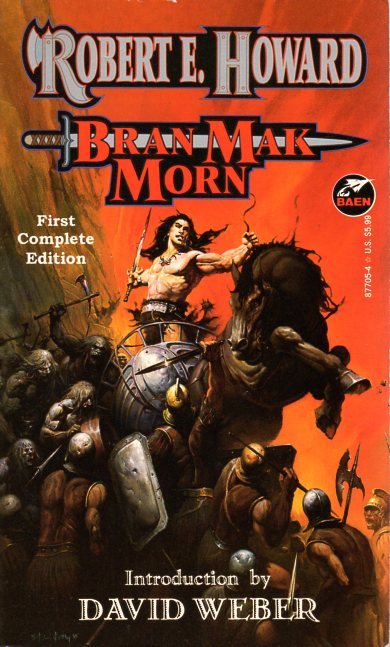
By Adrián Maldonado
I write about medieval barbarians in my legit academic work, and use this blog to explore how they occasionally escape from our powerpoint slides into the public consciousness.
I recently realized that for all my degrees, I didn’t know a thing about one of history’s most famous barbarians. It was high time I looked up Conan.
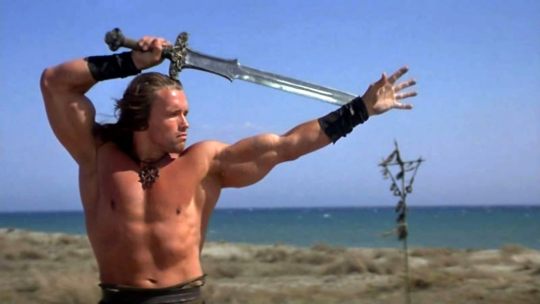
Stock image of Dark Age Europe
In my 80s childhood, Conan the Barbarian was a kind of folk character – a stock image of a beefy white guy in a furry loincloth with a giant sword. (I would probably be picturing Conan the Librarian, to be honest.) But I already had He-Man in my life, a knock-off Conan cartoon made to sell toys, though I could not have known that because the cartoon was so unspeakably awesome it would brook no questioning. Indeed, I only discovered the Schwarzenegger Conan films later on, when I was old enough to realize he had made other weird, non-science fiction films back in the Reagan era. I knew vaguely that the character was based on a book, or was it a comic book? This was before the internet, and before I could ever give a shit about a character with no good action figures.
Flash forward twenty years or so, when I am a grizzled Xennial hunched over his computer, writing about depictions of the Picts in pop culture. Immersed in terrible filmic depictions of ancient Scottish warriors (always warriors), it struck me that I had never thought about Conan the Barbarian. What kind of barbarian was he meant to be? Did his story take place in some kind of historical epoch? Were there Picts in it that I could add to my list?
Imagine my shock when I did find a Pict down this rabbit hole (or souterrain?), and he looked like this:
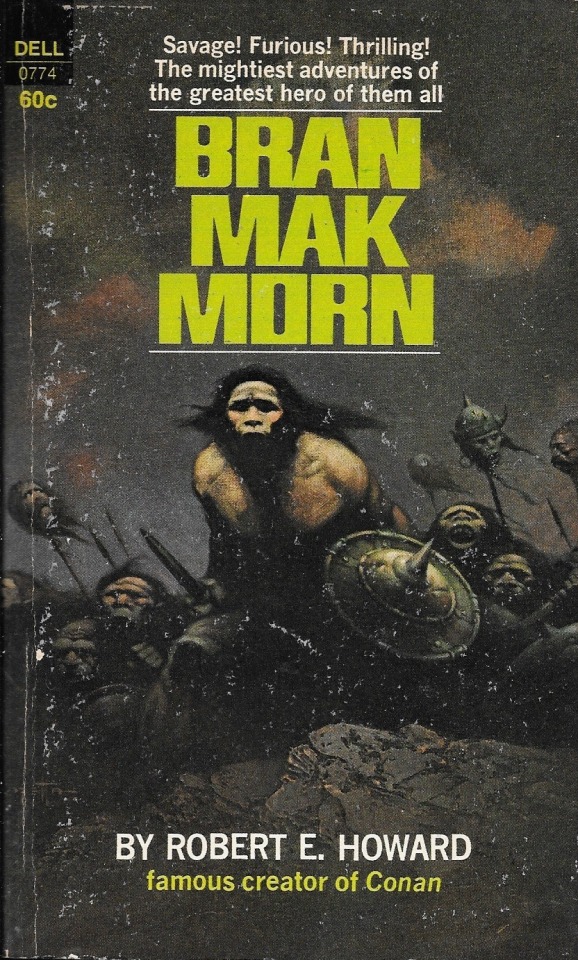
Whatever else I was working on, stopped.
***
Robert E. Howard is best known today as the creator of Conan the Barbarian. But little did I know that he was one of the first pop culture appropriators of the Picts. Indeed, he was writing about the Picts long before he even conceived of Conan. The Picts were his muse. I feel like this is important, and I may need more than one blog post to say why. But first, an introduction.
I had seen some hilarious renderings of Picts over the years, but they always fell into the usual stereotype of tattooed maniacs hurling themselves onto Roman spears.
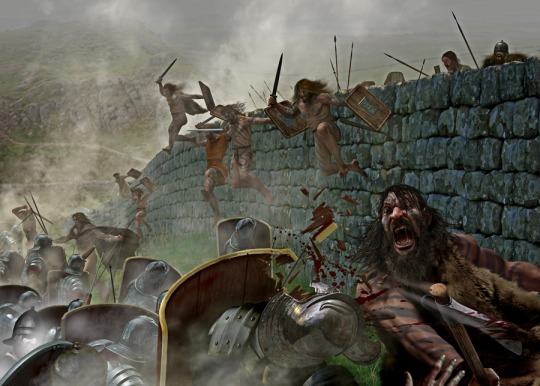
Tattooed maniacs hurling themselves onto Roman spears (source)
This 1960s paperback collection of stories by Howard entitled Bran Mak Morn, apparently the last king of the Picts, depicted this king Pict as a Neanderthal surrounded by howling ape-men. To me, this seemed like the purest distillation of the idea of the barbarians beyond the wall as sub-human, a trope developed in Roman imperial propaganda and continually reproduced today by the Hadrian’s Wall heritage ecosystem.
The paperback was one of a series of reprints of Howard’s genre-defining pulp fantasy of the 1920s and 1930s, brought back to life in the wake of the Tolkien wave of the 60s. Closer inspection revealed that Frank Frazetta’s 1969 cover image bore little resemblance to the description of Bran himself in Howard’s tales, even if his Pictish ‘race’ was certainly of a simian variety. More on this presently. What I wanted to know first was how a Texas kid learned about the Picts in the early 20th century, and came out with this.
***
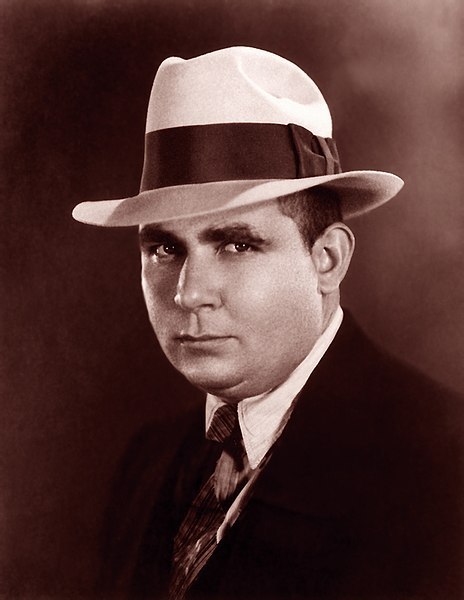
Robert E Howard had a tough childhood in his native Texas. Coming from a broken home, he moved around a lot and read books to keep himself company. In 1919, at the age of 13, his father dragged him to New Orleans while he took classes, so he squirrelled himself away in a library on Canal Street. It was there that he first read about the Picts in a book about British history. The image of a little, dark race from the north that hassled the Romans but could never be conquered fascinated him. Perhaps due to the ray of light this book gave him at a sensitive point in his childhood, the Picts remained ingrained in his mind for the rest of his short life, which he would later take in 1936, at the age of 30.
Like many other nerdy kids, he wrote stories to pass the time. In his archive were found several early writings which reveal the impact the Picts had on him. There is a school paper from 1920-23 about the Picts. The first story he ever submitted for publication was about the Picts, ‘The Lost Race’, but it was rejected by the editor of Weird Tales in 1924. He sold his first story later that year, beginning his professional writing career. A revised version of ‘The Lost Race’ was finally published in Weird Tales in 1927, introducing the world to Bran Mak Morn, a Pictish king who fought the Romans. He would go on to make several more appearances in Howard’s swords-and-sorcery tales, and the Picts eventually became one of the myriad ‘races’ in Howard’s Hyborian Age, a proto-prehistoric shared universe inhabited by Conan the Barbarian.
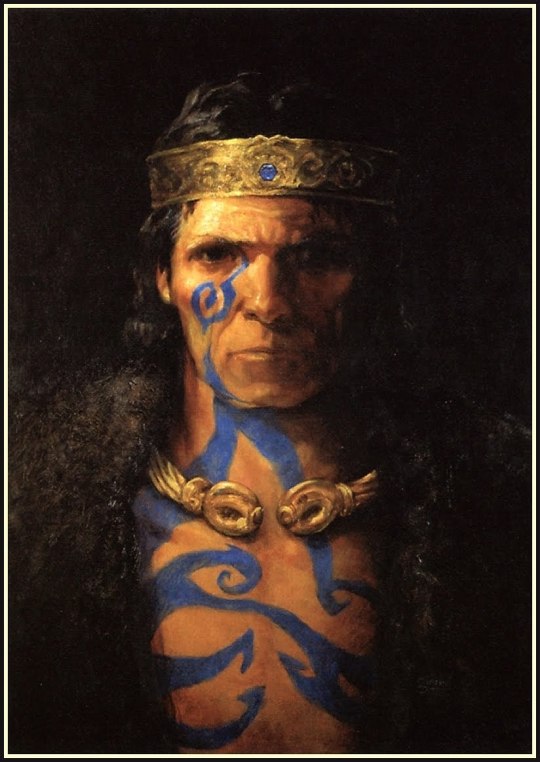
Bran Mak Morn by Gary Gianni (source)
Howard’s Picts are a peculiar bunch. From his first essay on them, he describes them as the remnants of the stone age inhabitants of Britain, comparing their appearance to Native Americans. In this view, they were the ‘Mediterraneans’ (as opposed to Celts or Nordics) who first brought the knowledge of farming to Britain in the Neolithic. They were eventually swept aside by the fair-skinned ‘Celtic’ race of metalworkers, at which point they were forced to mingle and interbreed with the indigenous cavemen, a barely human simian-like race. This meant that by the arrival of the Romans, the Picts had become stunted, swarthy, long-armed ape-men. All except Bran Mak Morn, their king, who had kept his bloodline pure. All pretty disgusting racial logic now, but hey, so the argument goes, it was the 20s.
Except that here it was, unfiltered and raw, in a book released during the height of the civil rights struggle in the United States. I bought this ancient artefact off of Amazon for pennies, and holding it in 2017, it felt like I’d acquired an illicit antiquity. Plenty of writers have tripped over themselves to call out and defend Tolkien and Howard regarding the racial (if not always racist) component to their mythical prehistories, so I won’t go down that route just now. But that cover image haunted me.
***
In 2005, Bran Mak Morn received a brand-new edition, the Weird Tales stories now bundled with unpublished manuscripts, fragments of Howard’s correspondence, and critical essays by Rusty Burke and Patrice Louinet. Armed with an annotated timeline of Howard’s Pictish writings, which spanned his career, and supplemented with google-fu, I was able to clarify the genesis of Bran Mak Morn.
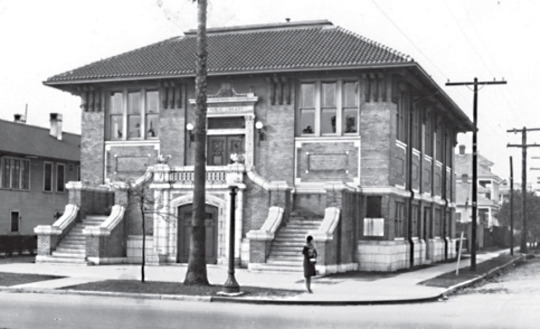
Former Canal Street public library, New Orleans, 1911 (source)
It is possible to trace the public library Howard visited when he was 13, when he first encountered a British history book and his vision of the dark, prehistoric Picts. The Canal Street public library in question must be the one that formerly stood at 2940 Canal Street at the corner of South Gayoso, opened in 1911. A photograph survives on the New Orleans library website, and Google Maps reveals it is now a Yoga studio.
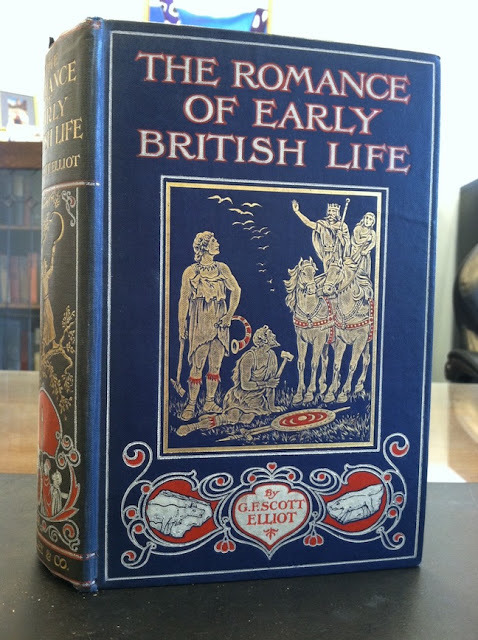
Origin myths of the Picts (source)
Rusty Burke has also plausibly identified the very book that Howard seems to have read: The Romance of Early British Life (1909) by George Francis Scott Elliot. This is apparently one of the flashy, pulpy ‘Library of Romance’ published by London-based Seeley and Co, described as ‘profusely illustrated’ ‘gift books’, which included among their number volumes such as The Romance of Modern Mining and The Romance of the World’s Fisheries. The author Scott Elliot was a botanist and antiquarian, president of Dumfries and Galloway Natural History and Antiquarian Society during an apparent low point in its history.
The fairly ridiculous book in question seems to have been written for Edwardian teenage boys, and does indeed bear the DNA of Howard’s later writing on the Picts: “In very ancient times Britain had been twice conquered, first by the small, dark Picts of the Mediterranean, and later (about 2000 or 1000 B.C.) by the tall, brown-haired, Gaelic-speaking Celts (237).” The chapter on the introduction of farming to Britain is called ‘The coming of the Picts’, in which Scott Elliot explains that they have been called by several names before – Homo Mediterraneus, Basques, Iberians, Silurians, the Firbolg, the Dolmen-builders – but he calls them Picts to save on ink (80-1). He claims they are still readily identifiable in the present day, as the short, brunette people who are mostly found in towns and cities, unlike the fairer Teutons or Kelts who prefer the countryside (92-3).
Howard’s vision of the Picts was thus formulated by the equivalent of our contemporary public archaeology, an accessible potted prehistory of Britain by one of Scotland’s leading antiquaries. Why this particular image, of a dark, forgotten people without a history, resonated so deeply with him, is a subject to ponder. But he was clearly not alone in his fascination. While racial views of the past soon died out in archaeological writing, they would go on to have a tenacious grip on the fantasy world. And which of these two genres do you think has a greater influence on people’s image of the medieval past?
***
Why does any of this matter? It is a demonstration of the role of ‘the Picts’, in various guises, as the untermenschen of what you might call western folk history. The fact that a young boy in inter-war Louisiana could head to the nearest library, read about them in a cheap history book, and then build a world-beating fictional universe that is still beloved today based on this is remarkable. As I’ve spent some time documenting on these pages, that image of the Picts is still in a way with us. A recent article in the Glasgow Herald has the reporter coming to the shocking insight that the Picts were not ‘hairy savages’ after speaking briefly to a couple of scholars. I wonder if that means we are doing our job well, or terribly.
It also opens up questions about the central role of race at the origins of both archaeology and the fantasy genre, a sticky subject that will have to be the subject of future blog posts [Editor's note: now read the follow-up to this post]. In the meantime, go check out similar topics being covered over on The Public Medievalist.
And hey, why not donate to your local public library while you’re at it?
***
Follow us on @AlmostArch
Header image via Jeff Black
5 notes
·
View notes
Text
Pistas de testes: veja algumas das mais incríveis do mundo
A Pirelli, um dos maiores fabricantes de pneus no mundo, inaugurou recentemente sua mais tecnológica pista de testes de pneus no mundo. Batizado de Circuito Panamericano, a pista fica em Elias Fausto (SP), distante cerca de 120 km da capital paulista.
O complexo tem sete pistas para diferentes tipos de teste, sendo o maior deles, para os testes de pista seca. Nesse trecho, a pista simula o traçado do autódromo de Estoril, em Portugal, e lugar da primeira vitória de Ayrton Senna na Fórmula 1.
Além de usar para desenvolvimento dos próprios produtos – pneus de carros e de motos -, a pista poderá ser alugada para eventos como track days, eventos de lançamentos, entre outros. O complexo tem uma área totla de 1.650.000 m² e de área construída e pavimentada são cerca de 205.000 m².
Mas a Pirelli não é a única empresa que tem a própria pista, para desenvolver seus produtos e também alugar para quem tiver dinheiro o suficiente para fazê-lo. Há muitas outras pistas ao redor do mundo que tem seus próprios donos e que podem ser alugadas – ou não.
Veja também
“Carros novos não t��m alma” diz estrela de ‘Louco por carros’
A história por trás do sucesso do Restauradores de Rust Valley do Netflix
Inscreva-se no canal do Jornal do Carro no YouTube
Veja vídeos de testes de carros e motos, lançamentos, panoramas, análises, entrevistas e o que acontece no mundo automotivo em outros países!
Inscrever-se
youtube
Confira outros exemplos:
TWIN RING MOTEGI. CRÉDITO: GOOGLE MAPS/REPRODUÇÃO
Honda / Suzuka e Twin Ring Motegi
A Honda é a mais “fominha” de todas. A marca japonesa tem, além de pistas de testes menores, dois autódromos no Japão que ela também usa para desenvolver seus produtos, carros e motos. Tamanho era o trabalho que ela criou uma empresa só para cuidar disso: a Mobilityland. Essa subsidiária é responsável por gerenciar o Circuito de Suzuka e o Autódromo Twin Ring Motegi.
O primeiro surgiu em 1962 e tem pouco mais de 5,8 km de extensão na maior configuração. O segundo ficou pronto em 1997 e tem 4,5 km. Mas na configuração original chegou a ter 6km. Nas duas pistas, entre outras categorias, já correram ou correm ainda, Fórmula 1, Fórmula Indy e MotoGP. Motegi é a casa da MotoGP no Japão e também onde está o maior museu da Honda no mundo. Suzuka, todo ano é palco de uma prova de longa duração de motos, a 8h de Suzuka.
CIRCUITO DE SUZUKA. CRÉDITO: GOOGLE MAPS/REPRODUÇÃO
Toyota / Circuito de Fuji
A grande rival da Honda, a Toyota não queria ficar para trás nessa briga. E foi assim que, em 2000, ela comprou a pista de Fuji do grupo Mitsubishi. Mas o nascimento da pista foi na década de 1960. Ela também já foi palco da Fórmula 1 e hoje, entre outras categorias, recebe a prova de longa duração de carros, a 8h de Fuji. Um dos carros desenvolvidos com o uso da pista é o Lexus LFA, superesportivo da marca de luxo da Toyota.
CIRCUITO DE FUJI. CRÉDITO: GOOGLE MAPS/REPRODUÇÃO
Ferrari / Fiorano e Mugello
Tal qual a Honda, a Ferrari é a outra “fominha” da lista. A marca italiana de superesportivos é dona de dois autódromos que não só servem como pista de testes para os carros de rua e de Fórmula 1 da companhia, mas também são abertas a competições: Fiorano e Mugello.
Outra similaridade da Ferrari e a Honda é que as duas tem uma pista em “formato de 8” No caso da italiana, Fiorano, e na Honda, Suzuka. A pista ficou pronta em 1972 e tem a casa que Enzo mandou construir em um terreno no qual ele tinha plena visão da pista de quase 3 km. O recorde da pista é da LaFerrari, com 1min20seg. Quando os testes privados de Fórmula 1 eram possíveis, Schumacher cravou 55,999 segundos, em 2004.
SCHUMACHER E SEUS CARROS DIANTE DA CASA DE ENZO FERRARI . CRÉDITO: FERRARI/DIVULGAÇÃO
Mugello, pista na qual a Fórmula 1 correrá este final de semana, surgiu como um circuito de rua em 1914 que chegou a ter 66 km. A pista atual, que conhecemos surgiu em 1974 e aproveitava da topografia da região para ter subidas e descidas, além de curvas que hoje imprimem quase 6G aos pilotos de Fórmula 1 nos carros atuais. Na década de 1980, foi remodelada pela Ferrari nos seus 5,2 km de extensão. A pista faz parte do calendário fixo da MotoGP desde 1994, esse ano, por causa do coronavírus a prova por lá foi cancelada.
MUGELLO CIRCUIT/DIVULGAÇÃO
BMW / Circuito de Miramas
Criado em 1924, o circuito de Miramas é pouco conhecido do público em geral. A pista francesa foi criada pelo piloto Paul Bablot em associação com o Automóvel Clube de Marseille, à época. A corrida mais famosa que passou pelo circuito foi um GP da França, em 1926, o precursor da Fórmula 1. Em 1986 ele foi comprado pela BMW que usa a pista para desenvolvimento de seus carros, motos e tecnologias de direção autônoma agora também.
PISTA DE MIRAMAS, NA FRANÇA. CRÉDITO: BMW/DIVULGAÇÃO
Porsche / Nardò
Desde 2012, a marca alemã é dona de uma das pistas de testes mais famosas do mundo: Nardò, no sul da Itália. Mas a história da gigantesca pista redonda começa muito antes disso. Ela foi criada em 1975 pela Fiat com quem ficou por muitos anos, antes de passar pela mão de empresas privadas, até a chegada da Porsche. Além da pista redonda, ela tem outros circuitos na parte interna para testes que não exijam velocidade.
A Porsche usa para seu desenvolvimento, mas também aluga para outras empresas que queiram realizar testes. Hoje, em condições normais, a velocidade máxima permitida é de 240 km/h na pista circular, mas em testes privados não há limites. A pista de 12,6 km e 4 km de diâmetro guarda o recorde de 388 km/h do Koenigsegg CCR e do conceito VW Nardò que percorreu 7,740.576 km em 24 horas a uma velocidade média de 322 km/h.
PORSCHE/DIVULGAÇÃO
Volkswagen / Ehra-Lessien
Com um nome que parece estranho, Ehra-Lessien, a pista de testes privada da Volkswagen, trancada em meio a floresta, ficou famosa graças ao Bugatti Veyron. Nos arredores de Wolfsburg, a pista foi criada em 1965 em uma zona de limite entre as Alemanhas do pós-guerra. O local era perfeito, pois tinha restrição de voo.
São 96 km de pistas para diversas propostas, mas de longe, a mais interessante é a reta de 9 km. Ela é tão comprida que não é possível enxergar a outra extremidade graças a inclinação natural da terra (sim, a terra é redonda). E foi lá que o Veyron Super Sport atingiu a velocidade de 431 km/h de média entre duas passagens, uma em cada sentido, para referendar seu recorde. Além das pistas, Ehra-Lessien é a joia da coroa do grupo Volkswagen, onde todas as inovadoras tecnologias que vão surgir e dar lucros para as empresas são testadas em laboratórios ultra-secretos.
EHRA-LESSIEN COM RETA DE 9 KM. CRÉDITO: GOOGLE MAPS/REPRODUÇÃO
Pistas de testes: veja algumas das mais incríveis do mundo apareceu primeiro em: https://jornaldocarro.estadao.com.br
0 notes
Text
Pistas de testes: veja algumas das mais incríveis do mundo
A Pirelli, um dos maiores fabricantes de pneus no mundo, inaugurou recentemente sua mais tecnológica pista de testes de pneus no mundo. Batizado de Circuito Panamericano, a pista fica em Elias Fausto (SP), distante cerca de 120 km da capital paulista.
O complexo tem sete pistas para diferentes tipos de teste, sendo o maior deles, para os testes de pista seca. Nesse trecho, a pista simula o traçado do autódromo de Estoril, em Portugal, e lugar da primeira vitória de Ayrton Senna na Fórmula 1.
Além de usar para desenvolvimento dos próprios produtos – pneus de carros e de motos -, a pista poderá ser alugada para eventos como track days, eventos de lançamentos, entre outros. O complexo tem uma área totla de 1.650.000 m² e de área construída e pavimentada são cerca de 205.000 m².
Mas a Pirelli não é a única empresa que tem a própria pista, para desenvolver seus produtos e também alugar para quem tiver dinheiro o suficiente para fazê-lo. Há muitas outras pistas ao redor do mundo que tem seus próprios donos e que podem ser alugadas – ou não.
Veja também
“Carros novos não têm alma” diz estrela de ‘Louco por carros’
A história por trás do sucesso do Restauradores de Rust Valley do Netflix
Inscreva-se no canal do Jornal do Carro no YouTube
Veja vídeos de testes de carros e motos, lançamentos, panoramas, análises, entrevistas e o que acontece no mundo automotivo em outros países!
Inscrever-se
youtube
Confira outros exemplos:
TWIN RING MOTEGI. CRÉDITO: GOOGLE MAPS/REPRODUÇÃO
Honda / Suzuka e Twin Ring Motegi
A Honda é a mais “fominha” de todas. A marca japonesa tem, além de pistas de testes menores, dois autódromos no Japão que ela também usa para desenvolver seus produtos, carros e motos. Tamanho era o trabalho que ela criou uma empresa só para cuidar disso: a Mobilityland. Essa subsidiária é responsável por gerenciar o Circuito de Suzuka e o Autódromo Twin Ring Motegi.
O primeiro surgiu em 1962 e tem pouco mais de 5,8 km de extensão na maior configuração. O segundo ficou pronto em 1997 e tem 4,5 km. Mas na configuração original chegou a ter 6km. Nas duas pistas, entre outras categorias, já correram ou correm ainda, Fórmula 1, Fórmula Indy e MotoGP. Motegi é a casa da MotoGP no Japão e também onde está o maior museu da Honda no mundo. Suzuka, todo ano é palco de uma prova de longa duração de motos, a 8h de Suzuka.
CIRCUITO DE SUZUKA. CRÉDITO: GOOGLE MAPS/REPRODUÇÃO
Toyota / Circuito de Fuji
A grande rival da Honda, a Toyota não queria ficar para trás nessa briga. E foi assim que, em 2000, ela comprou a pista de Fuji do grupo Mitsubishi. Mas o nascimento da pista foi na década de 1960. Ela também já foi palco da Fórmula 1 e hoje, entre outras categorias, recebe a prova de longa duração de carros, a 8h de Fuji. Um dos carros desenvolvidos com o uso da pista é o Lexus LFA, superesportivo da marca de luxo da Toyota.
CIRCUITO DE FUJI. CRÉDITO: GOOGLE MAPS/REPRODUÇÃO
Ferrari / Fiorano e Mugello
Tal qual a Honda, a Ferrari é a outra “fominha” da lista. A marca italiana de superesportivos é dona de dois autódromos que não só servem como pista de testes para os carros de rua e de Fórmula 1 da companhia, mas também são abertas a competições: Fiorano e Mugello.
Outra similaridade da Ferrari e a Honda é que as duas tem uma pista em “formato de 8” No caso da italiana, Fiorano, e na Honda, Suzuka. A pista ficou pronta em 1972 e tem a casa que Enzo mandou construir em um terreno no qual ele tinha plena visão da pista de quase 3 km. O recorde da pista é da LaFerrari, com 1min20seg. Quando os testes privados de Fórmula 1 eram possíveis, Schumacher cravou 55,999 segundos, em 2004.
SCHUMACHER E SEUS CARROS DIANTE DA CASA DE ENZO FERRARI . CRÉDITO: FERRARI/DIVULGAÇÃO
Mugello, pista na qual a Fórmula 1 correrá este final de semana, surgiu como um circuito de rua em 1914 que chegou a ter 66 km. A pista atual, que conhecemos surgiu em 1974 e aproveitava da topografia da região para ter subidas e descidas, além de curvas que hoje imprimem quase 6G aos pilotos de Fórmula 1 nos carros atuais. Na década de 1980, foi remodelada pela Ferrari nos seus 5,2 km de extensão. A pista faz parte do calendário fixo da MotoGP desde 1994, esse ano, por causa do coronavírus a prova por lá foi cancelada.
MUGELLO CIRCUIT/DIVULGAÇÃO
BMW / Circuito de Miramas
Criado em 1924, o circuito de Miramas é pouco conhecido do público em geral. A pista francesa foi criada pelo piloto Paul Bablot em associação com o Automóvel Clube de Marseille, à época. A corrida mais famosa que passou pelo circuito foi um GP da França, em 1926, o precursor da Fórmula 1. Em 1986 ele foi comprado pela BMW que usa a pista para desenvolvimento de seus carros, motos e tecnologias de direção autônoma agora também.
PISTA DE MIRAMAS, NA FRANÇA. CRÉDITO: BMW/DIVULGAÇÃO
Porsche / Nardò
Desde 2012, a marca alemã é dona de uma das pistas de testes mais famosas do mundo: Nardò, no sul da Itália. Mas a história da gigantesca pista redonda começa muito antes disso. Ela foi criada em 1975 pela Fiat com quem ficou por muitos anos, antes de passar pela mão de empresas privadas, até a chegada da Porsche. Além da pista redonda, ela tem outros circuitos na parte interna para testes que não exijam velocidade.
A Porsche usa para seu desenvolvimento, mas também aluga para outras empresas que queiram realizar testes. Hoje, em condições normais, a velocidade máxima permitida é de 240 km/h na pista circular, mas em testes privados não há limites. A pista de 12,6 km e 4 km de diâmetro guarda o recorde de 388 km/h do Koenigsegg CCR e do conceito VW Nardò que percorreu 7,740.576 km em 24 horas a uma velocidade média de 322 km/h.
PORSCHE/DIVULGAÇÃO
Volkswagen / Ehra-Lessien
Com um nome que parece estranho, Ehra-Lessien, a pista de testes privada da Volkswagen, trancada em meio a floresta, ficou famosa graças ao Bugatti Veyron. Nos arredores de Wolfsburg, a pista foi criada em 1965 em uma zona de limite entre as Alemanhas do pós-guerra. O local era perfeito, pois tinha restrição de voo.
São 96 km de pistas para diversas propostas, mas de longe, a mais interessante é a reta de 9 km. Ela é tão comprida que não é possível enxergar a outra extremidade graças a inclinação natural da terra (sim, a terra é redonda). E foi lá que o Veyron Super Sport atingiu a velocidade de 431 km/h de média entre duas passagens, uma em cada sentido, para referendar seu recorde. Além das pistas, Ehra-Lessien é a joia da coroa do grupo Volkswagen, onde todas as inovadoras tecnologias que vão surgir e dar lucros para as empresas são testadas em laboratórios ultra-secretos.
EHRA-LESSIEN COM RETA DE 9 KM. CRÉDITO: GOOGLE MAPS/REPRODUÇÃO
https://jornaldocarro.estadao.com.br/fanaticos/pista-de-testes-montadoras/ visto pela primeira vez em https://jornaldocarro.estadao.com.br
0 notes
Text
Teens And Drug Use - Detection And Approach
youtube
Infuse the dry leaves with boiling water to create a wonderful natural tea. High-quality for sluggish liver and upset stomach fat.You can mix with nettle leaves or fresh mint leaves for just a different taste and more healing areas. The oldest painted surfaces on earth were designed with forms of milk paint Cannabis Study . Cave drawings and paintings were made having a simple composition of milk, lime, and natural earth or vegetative pigments. When King Tutankhamen's tomb was opened in 1924 artifacts, including forms of boats, people, and furniture inside the burial chamber, had been painted with milk car paint. Until World War II, metric scale system still painted houses and furniture it will. However, cognizant careful selecting your fish-oil product. Purchase only high grade fish oil available presently which additionally known as pharmaceutical grade fish fish oil. This grade is clinically tested in fact it is approved for consumption by health specialists all over the world. The latest application for the Apple iPhone is "Cannabis ;" a $3.00 app which lets users search by city due to the fact nearest cannabis supplier. According to U.K.'s The Sun, it currently covers 13 Ough.S. states which have passed laws allowing medical marijuana use, legal cannabis "coffee shops" across Europe and uses Google Maps for directions. It is available through your Apple iTunes App Store now, and requirements the iPhone 3.0 Software Update. The right thing so you can do is use only natural ingredients and create your own skin maintenance systems. Mother Nature a person with the better ingredients which use for natural natual skin care for confront and pores and skin. You can use such as honey as a good moisturizer. You can add oatmeal and yogurt to the honey and you can now have made yourself the nice exfoliant you will get. BloomField CBD Oil Oil Benefits likewise a wonderful thing to be able to use to hydrate deal with. Tea tree oil is the most thing to use in your skin across and operates to kill organisms. It can also work well for treating blemishes and cuts. Many store-bought brands of soap claim they leave no residue on the skin after rinsing, which On the net to thought of whole lot of hooey. These soaps simply leave residue, but also leave the skin feeling dry and itches. As previously mentioned, the different places to view are within reasonable walking distance. The farthest being around 7.5 miles. The landscape of Amsterdam is interesting to make out. The city is lined with over 160 waterways. Taking a boat ride through these canals is a must. Honestly there are tour companies on every corner. The rides can be anywhere from 5 minutes to 5 hours, from sight-seeing to dinner bouncing. We did a 30 minute canal ride for around $10 each and every single. It was relaxing and quite scenic. It must be mentioned that having a houseboat is pretty common simply too. You will even have choosing renting them as a resource of lodging during your stay. Although I recommend hotels since they will be cheaper likewise sway a bit less. As for protein, individuals still have enough misconception may need far more protein than they really attain. If you think about mother's milk, which only contains i.5 - 2.5 % protein perhaps may relax just a little bit about your protein uptake. Growing children and athletes need one of the most protein. There's way more protein in dark leafy greens than most people realize. Tahini, BloomField CBD Reviews CBD almond butter, almonds and BloomField CBD sunflower seeds are also all easy sources of protein. But it is only about impossible to take any current program and apply it to a raw technique. Everything changes when you take the raw food approach. What used to harm turn into good anyone personally in the uncooked repeat. So, don't fear the fat cells! Just keep all your fat consumption the healthy kind-if you eat any cooked food, certain that it isn't cooked built up fat. Isn't that simple?
0 notes
Video
youtube
Uzbekistan Family Tour - Samarkand Tours Operator – 998998520077
Uzbekistan Family Tour
The Uzbekistan Family Tour combines three ancient cities - Tashkent, Samarkand and Bukhara - with interactive museums, amusement parks, crafts classes, and performances that are interesting for children. The Polytechnic Museum in Tashkent is a favorite for its science-based exhibits, while Samarkand hosts masterclasses in papermaking and cooking traditional pilaf. Enjoy a ceramics class and a puppet performance in Bukhara, before returning back to Tashkent. Combining visits to historical places with an active cultural program, this is the best tour for keeping busy while also fully immersing yourself and your family in the life of Uzbekistan.
The history of Tashkent totals more than 2500. The history of the city began from the small settlement of juice (the VI-III centuries BC) assume. For the long history the city was called differently – as Euny, Chach, Shash-Tep, Binkent, Tashkent.
In the I-IV centuries Chach was a part of the Kushansky kingdom. In the V century the city was grasped by eftalits created the huge power in the territory of all Central Asia, and in the 6th century it appeared under the influence of Turkic kaganat. At this time begins formation of Turkic language at the people of this edge.
At the beginning of the VIII century the Arab armies passed Amu Darya and began a gain of Central Asia. In the beginning were grasped Bukhara, Samarkand, and in 716 g – Chach (Tashkent). The population of Chach leaves the city devastated by Arabs, and creates the new city, but not on ruins, and in 4-5 km to the northwest from former, on the bank of Boz-su canal.
At this time, on the territory of Central Asia extend Islam religion, the Arab writing and culture. From IX century the city strongly located in the center of an “old” part of modern Tashkent and is called as the Arab name “Binkent” (i.e. the main town of area). And this period, the IX-X centuries, was really «a gold eyelid» in the history of economic, and especially, cultural development of the region called the period of «the Muslim Renaissance».
Samarkand, also Samarqand is perhaps the most famous city of modern Uzbekistan. The site of Samarkand was settled about 2000 BC. In times of old the city was also known as Afrosiab, and also Maracanda by the Greeks. The city was the capital of Sogdiana, an ancient Persian province, and was conquered by Alexander the Great in 329 BC. It subsequently grew as a trade center on the route between China and the Mediterranean region. In the early 8th century AD, it was conquered by the Arabs and soon became an important center of Muslim culture. In 1220 Samarkand was almost completely destroyed by the Mongol ruler Genghis Khan. It flourished again when Tamerlane (known as Timur��locally) ade it the capital of his empire in 1369. As his capital Timur put Samarkand on the world map and much of the architecture visible today was built by him or his descendants. The empire declined in the 15th century, and nomadic Uzbeks (Shaybanids) took Samarkand in 1500. In 1784 the emirate of Bukhara conquered it. The city was taken by Russia in 1868 and once again began to assume importance. From 1924 to 1930, Samarqand was the capital of the Uzbek Soviet Socialist Republic (SSR).
Bukhara, which is situated on the Silk Route, is more than 2,000 years old. It is the most complete example of a medieval city in Central Asia, with an urban fabric that has remained largely intact. Monuments of particular interest include the famous tomb of Ismail Samani, a masterpiece of 10th-century Muslim architecture, and a large number of 17th-century madrasas.
Plus code:
86CX+GP Tashkent, Uzbekistan
Address:
Samarkand Tours Operator
Yunusabad 19-35-87
Tashkent ,100114,
Uzbekistan
998998520077
https://samarkandtours.com/tour/uzbekistan-family-tour/
https://www.google.com/maps/d/u/4/viewer?mid=1_BXKxgbkJidiOw1uA2lGoTQTliH_jNlx&ll=40.48768883313375%2C66.80615914999998&z=7
Video on youtube:
https://youtu.be/G7nTApM7yE0
Searching keyword:
Uzbekistan Family Tour
#UzbekistanFamilyTour
0 notes
Text

Imperial Tobacco Company
102-116 South Sixth Streets (Warehouse & Stemmery)
Built, between 1877 - 1896
Demolished, unknown
118-120 South Sixth Street (Office)
Built, 1904
Demolished, after 1977
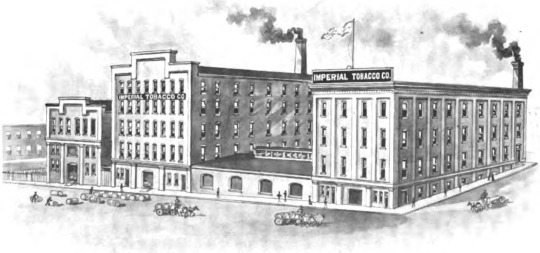
[RVCJ03] — showing Stemmery & Warehouse at Sixth & Main SW
The British tobacco bully-boys. What’s wrong with a little friendly competition?
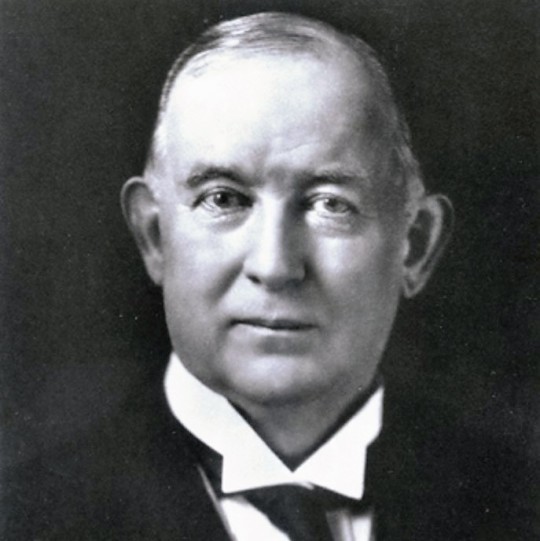
(Duke University Libraries) — James Buchanan Duke
This is one of the quaint stories of the Gilded Age, those good old days when men were men and trusts were normal.
The American Tobacco Company (ATC) set aside a massive 30 million dollars to buy up British tobacco companies one by one at the start of the 20th century. The key figure was James Buchanan Duke, head of ATC, whose aggressive methods had created a virtual monopoly for the company in the US. Individually, British companies, even those of the size of WD & HO Wills and John Player & Sons, could not survive.
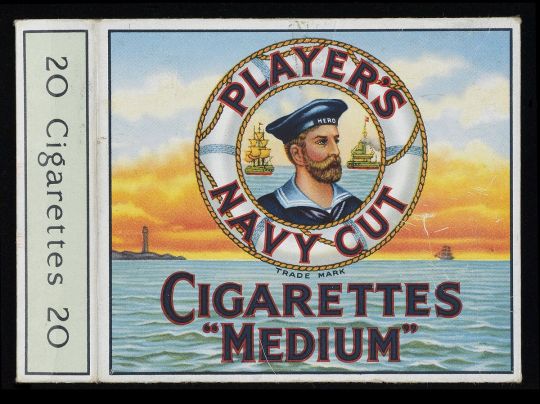
(Wikimedia Commons)
When Duke arrived in Liverpool in 1901, he walked into Ogden's factory and bought on the spot. Duke then approached other British companies and is reported to have burst in on the Player brothers, saying: "Hello, boys. I'm Duke from New York, come to take over your business." He was politely shown the door, an experience repeated at other companies. Facing such resistance, he paused for reflection.
This pause gave 13 family-run businesses, led by Wills, Players and Lambert & Butler, time to meet and, in December 1901, The Imperial Tobacco Company (Great Britain and Ireland) Limited was formed. (Imperial Tobacco)
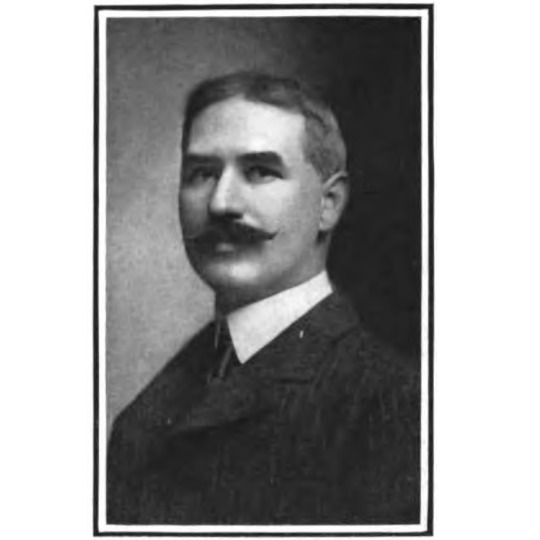
[RVCH03] — Wellford C. Reed
Duke’s bluster would come back to haunt him, and it wasn’t long until the fight was brought directly to American Tobacco’s doorstep.
According to information received in the city, Mr. A. F. Thomas of Lynchburg, who, along with Mr. Wellford C. Reed, of this city, was appointed to represent the Imperial Tobacco Company in this country, will remove to this city and will establish himself here. He as sold out his place in Lynchburg and is preparing to make a change in his residence. It is understood that he will come here tomorrow, though hardly to settle here so soon. This will probably be a preliminary visit, with a view to securing residence, office, &c.
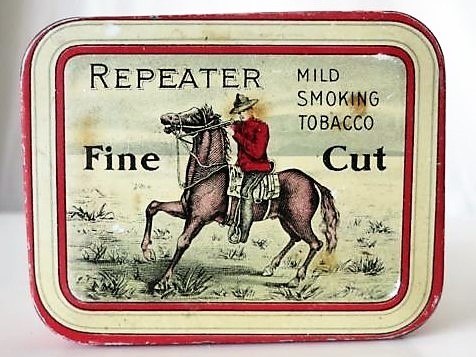
(Pinterest) — tin of Repeater, fine cut mild smoking tobacco, product of Imperial Tobacco Company of Montreal, Canada
The determination of Mr. Thomas to locate here casts more mystery than ever over the plans of the Imperial Company with reference to this country. When he and Mr. Reed were appointed it was thought that the two would divide the territory between them, Mr. Reed looking after Virginia and the Carolinas and Mr. Thomas the West, or vice versa. This arrangement seems to be knocked in the head by Mr. Thomas’ action in locating here. It may be, however, that he will undertake to conduct the Western business from this point. One thing seems to be signified by the coming of Mr. Thomas to this city, namely: that Richmond will in reality be the American headquarters of the Imperial. [RT19020315]
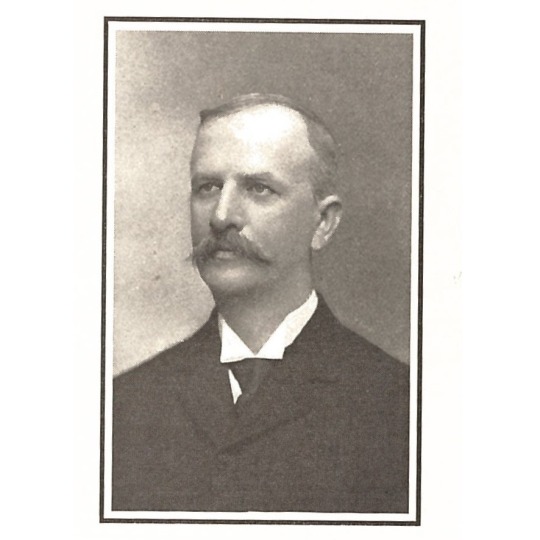
[RVCJ03] — James N. Boyd
They started by taking over the buildings of James N. Boyd, a former leaf tobacco broker who’d found a new occupation as President of the Planters Bank and Virginia Trust Company. His warehouse and stemmery��commanded most of the western block of Sixth Street between Cary and Canal Streets, a clear finger in the face to Duke, whose American Tobacco buildings stood right across the street.
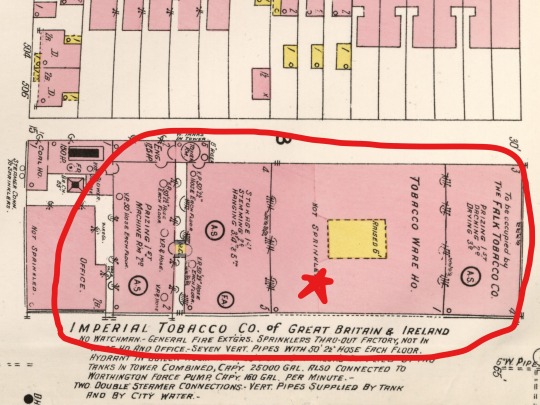
(Library of Congress) — Sanborn Fire Insurance Map from Richmond (1905) — Plate 11 — showing 102-116 South Sixth Street locations
Nor did it take long for Imperial to make its presence known, leaning hard on its British brethren to not do business with American Tobacco.
London, March 21 — At a meeting of the Edinburg Association of Retail Tobacconists, to-day, a resolution was adopted unanimously declining to sign the Imperial Tobacco Company’s agreement not to sell American goods for a term of years, but expressing a willingness, if the minimum price is raised so as to allow a fair profit to the dealers, to do what is possible, bonus or no bonus, for the sake of British goods. The chairman declared that no one outside a lunatic asylum would sign such an agreement, which would make them the servants of the Imperial Tobacco Company. While the Americans offered a large bonus, no restrictions were placed upon the dealers. [RD19020322]
Indeed, the London tobacconists felt that Imperial Tobacco Company offer “out-Americanized the Americans” and was “unjust and unfair to the dealers, and un-English.”
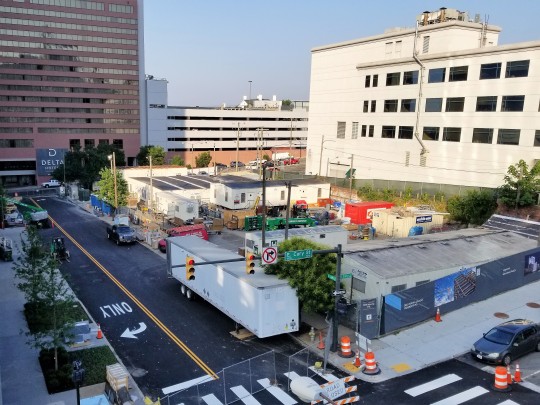
May 2019 — looking towards 102-116 South Sixth Street today
Such resistance had limits, as Imperial continued to come out swinging, with two announcements in May alone.
The Universal Tobacco Company of this country, it is learned, will work with the Imperial Tobacco Company, of Great Britain, against their common foe, the American Tobacco Company, through a co-operative alliance altogether different from what has bee supposed.
The scheme of co-operation, according to the information received, is to have the Universal Tobacco Company become the selling agents for the Imperial in the country and the Imperial for the Universal in England and Europe.
Such an alliance would be an exceedingly strong one and would be hard to beat. [RT19020511]

[RTD19040177] — Plans for Imperial Tobacco Company’s Splendid Office Building, Sixth and Cary — Richmond Times-Dispatch, Sunday, January 17, 1904
This was followed just three days later with the announcement of the acquisition of the Well-Whitehead Tobacco Company of Wilson, North Carolina.
In July, the Richmond Dispatch announced that British tobacco dealers had been notified that the Imperial was arranging for direct imports of Virginia and Carolina leaf, effectively freezing out American firms from selling to British manufacturers. Later the same month, the Dispatch ran another story that described Imperial’s intention to compete aggressively in the Farmville market during the next tobacco-buying season.
While the general public know nothing of the merits of the alleged controversy between the Imperial and American “giants,” every farmer is in high hopes of larger profits from his labors by reason of the anticipated struggle between these companies. [RD19020713]
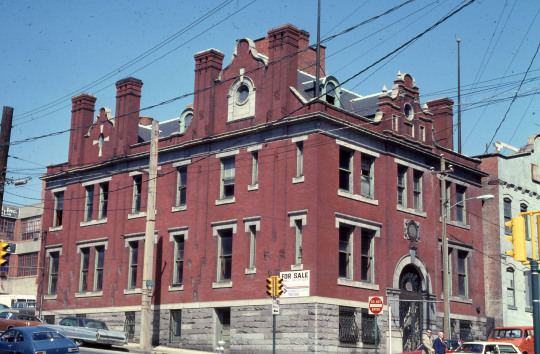
(Vintage Richmond) — Imperial Tobacco Company building — March 1977
Duke tried fighting back.
Through Ogden's, American Tobacco Company began cutting prices and offering free gifts in the UK - tactics that had served it well in the US. But Imperial frustrated ATC at every turn. It acquired the retail business of Salmon & Gluckstein and also set up a customer bonus scheme, whereby a proportion of Imperial profits was distributed among wholesale and retail customers.
After suffering heavy losses in the UK, and faced with a trade war at home, ATC was ready to talk. In September 1902 an agreement was reached - ATC surrendered Ogden's to Imperial while Imperial abandoned plans to enter the American market, except for leaf buying. The result was the formation of the British American Tobacco Company Limited. (Imperial Tobacco)
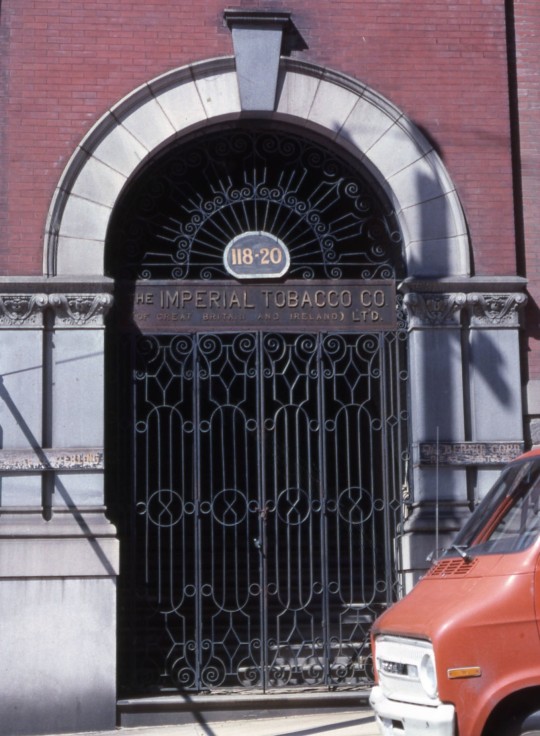
(Vintage Richmond) — Imperial Tobacco Company doorway — March 1977
The cessation of hostilities allowed Imperial the luxury of planning a brand new office building, which was constructed in 1904, right across the street from the warehouse and stemmery. Sadly, the giddy good times did not last.
In 1907, American Tobacco Company was indicted in violation of the Sherman Anti-Trust Act of 1890. They fought it all the way to the Supreme Court, and in 1911, the justices issued their decision in United States v. American Tobacco Company, holding that American was indeed guilty of attempting to monopolize the business of tobacco in interstate commerce.
The tobacco giant was split into four smaller companies: American Tobacco Company, R. J. Reynolds, Liggett & Myers, and Lorillard. American Tobacco continued to hold the rights to sell a number of Imperial brands in the US, leaving Imperial free to export any of its other brands to the American market. (Imperial Tobacco)
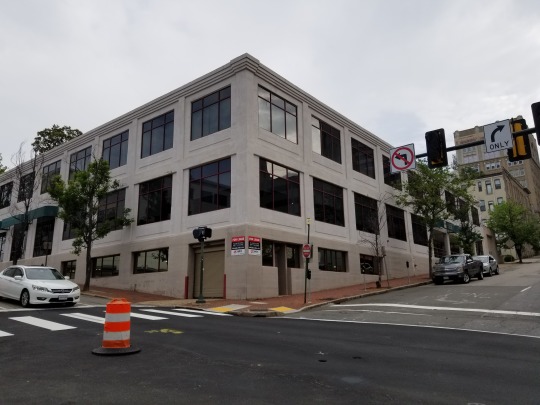
May 2019 — looking toward 118-120 South Sixth Street today
Imperial may have seen the writing on the wall and elected to bail for greener pastures. A 1908 article in the Richmond Times-Dispatch discusses the company’s contemplated move to Henderson, Kentucky, and their transformation into Imperial of Kentucky. Great things were anticipated from the exploitation of the great Western tobacco belt, and they expected to construct a new rehandling plant in Henderson. [RTD19080305]
The warehouse and stemmery buildings continued to be used by Imperial as late as 1924, but the office building became a warehouse for the Western Electric Company, and then Graybar Electric by 1950.
(Imperial Tobacco Company is part of the Atlas RVA! Project)
Note
The always readable Shockoe Examiner has plowed this same topic in a post from 2018. There are additional pictures and details about the office building that are worth checking out.
Print Sources
Newspapers provided by Chronicling America.
[RT19020315] Richmond Times. Saturday, March 15, 1902.
[RD19020322] Richmond Dispatch. Saturday, March 22, 1902.
[RT19020511] Richmond Times. Sunday, May 11, 1902.
[RD19020713] Richmond Times. Sunday, July 13, 1902.
[RTD19040177] Richmond Times-Dispatch. Sunday, January 17, 1904.
[RTD19080305] Richmond Times-Dispatch. Thursday, March 5, 1908.
[RVCJ03] Richmond, Virginia: The City on the James: The Book of Its Chamber of Commerce and Principal Business Interests. G. W. Engelhardt. 1903.
1 note
·
View note
Text
Majestic Tower
Majestic Tower Bal Harbour
9601 Collins Avenue, Bal Harbour, FL 33154
< Back to Miami Luxury Condos
Majestic Tower Bal Harbour.
Building Stats: Year Built: 1998 Stories: 22 Total Units: 153 Bedrooms: 2 to 4 Sq.Ft. Range: 2,160 to 3,960 Sq.Ft.
Tags:
Bal Harbour Oceanfront Ultra-Luxury
Majestic Tower
See Also:
Bellini Bal Harbour Oceana Bal Harbour One Bal Harbour St. Regis Bal Harbour
Floorplans:
youtube
.overlay_modal {position:fixed !important;} .overlay_modal .login-modal {width: 403px !important;} @media screen and (max-width: 800px) { div#map-actions{display: none;} } .flex-slider-item-hidden { display: none; } .flex-lazy-image { -webkit-transform: scale(1) !important; -ms-transform: scale(1) !important; transform: scale(1) !important; } .create-alert-footer { position: relative !important; width: 150px !important; background-color: white !important; opacity: 1 !important; padding: 0px !important; right: 0px !important; font-size: 15px !important; left: 10px; top: 0px !important; } .view-list .flex-property-new-listing { display: none; } @media screen and (max-width: 800px) { div#map-actions{display: none;} } .wrap-slider li img { opacity: 0; transition: opacity 0.5s linear; } .wrap-slider li img.flex-lazy-image.loaded { opacity: 1; } .gm-style>div>div>div>div:first-child { height: auto !important; } var filter_metadata = null; var search_metadata = {"amenities":[{"name":"Swimming Pool","code":"pool"},{"name":"Golf Course","code":"golf"},{"name":"Tennis Courts","code":"tennis"},{"name":"Gated Community","code":"gated_community"},{"name":"Lofts","code":"loft"},{"name":"Penthouse","code":"penthouse"},{"name":"Water Front","code":"water_front"},{"name":"Pets","code":"pets"},{"name":"Furnished","code":"furnished"},{"name":"Equestrian","code":"equestrian"}],"baths_range":[{"label":"0","value":0},{"label":" ","value":0.5},{"label":"1","value":1},{"label":" ","value":1.5},{"label":"2","value":2},{"label":" ","value":2.5},{"label":"3","value":3},{"label":" ","value":3.5},{"label":"4","value":4},{"label":" ","value":4.5},{"label":"5","value":5},{"label":" ","value":5.5},{"label":"5+","value":6}],"beds_range":[{"label":"Studio","value":0},{"label":"1","value":1},{"label":"2","value":2},{"label":"3","value":3},{"label":"4","value":4},{"label":"5","value":5},{"label":"5+","value":6}],"cities":[{"name":"Aventura","code":2},{"name":"Bal Harbour","code":3},{"name":"Bay Harbor Islands","code":4},{"name":"Brickell","code":144},{"name":"Brickell Key","code":145},{"name":"Coconut Grove","code":12},{"name":"Coral Gables","code":14},{"name":"Doral","code":21},{"name":"El Portal","code":23},{"name":"Fisher Island","code":25},{"name":"Golden Beach","code":29},{"name":"Indian Creek","code":42},{"name":"Kendall","code":48},{"name":"Key Biscayne","code":49},{"name":"Miami","code":61},{"name":"Miami Beach","code":62},{"name":"Miami Gardens","code":63},{"name":"Miami Lakes","code":64},{"name":"Miami Shores","code":65},{"name":"Miami Springs","code":66},{"name":"Miramar","code":68},{"name":"North Bay Village","code":70},{"name":"North Miami","code":72},{"name":"North Miami Beach","code":73},{"name":"Pinecrest","code":91},{"name":"South Miami","code":102},{"name":"Sunny Isles Beach","code":106},{"name":"Surfside","code":108}],"default_sort":"price-desc","default_view":"grid","living_size_range":[{"label":"0","value":0},{"label":"500","value":500},{"label":"600","value":600},{"label":"700","value":700},{"label":"800","value":800},{"label":"900","value":900},{"label":"1000","value":1000},{"label":"1250","value":1250},{"label":"1500","value":1500},{"label":"1750","value":1750},{"label":"2000","value":2000},{"label":"2500","value":2500},{"label":"3000","value":3000},{"label":"3500","value":3500},{"label":"4000","value":4000},{"label":"4500","value":4500},{"label":"5000","value":5000},{"label":"6000","value":6000},{"label":"7000","value":7000},{"label":"8000","value":8000},{"label":"9000","value":9000},{"label":"10000","value":10000},{"label":"11000","value":11000},{"label":"12000","value":12000},{"label":"13000","value":13000},{"label":"14000","value":14000},{"label":"15000","value":15000},{"label":"16000","value":16000},{"label":"17000","value":17000},{"label":"18000","value":18000},{"label":"19000","value":19000},{"label":"20000","value":20000},{"label":"30000","value":30000},{"label":"40000","value":40000},{"label":"50000","value":50000},{"label":"60000","value":60000},{"label":"70000","value":70000},{"label":"80000","value":80000}],"lot_size_range":[{"label":"0","value":0},{"label":"500","value":500},{"label":"600","value":600},{"label":"700","value":700},{"label":"800","value":800},{"label":"900","value":900},{"label":"1000","value":1000},{"label":"1250","value":1250},{"label":"1500","value":1500},{"label":"1750","value":1750},{"label":"2000","value":2000},{"label":"2500","value":2500},{"label":"3000","value":3000},{"label":"3500","value":3500},{"label":"4000","value":4000},{"label":"4500","value":4500},{"label":"5000","value":5000},{"label":"6000","value":6000},{"label":"7000","value":7000},{"label":"8000","value":8000},{"label":"9000","value":9000},{"label":"10000","value":10000},{"label":"11000","value":11000},{"label":"12000","value":12000},{"label":"13000","value":13000},{"label":"14000","value":14000},{"label":"15000","value":15000},{"label":"16000","value":16000},{"label":"17000","value":17000},{"label":"18000","value":18000},{"label":"19000","value":19000},{"label":"20000","value":20000},{"label":"30000","value":30000},{"label":"40000","value":40000},{"label":"50000","value":50000},{"label":"60000","value":60000},{"label":"70000","value":70000},{"label":"80000","value":80000}],"parking_options":[{"label":"1","value":1},{"label":"2","value":2},{"label":"3","value":3},{"label":"4","value":4},{"label":"5","value":5},{"label":"5+","value":6}],"price_rent_range":[{"label":"$0","value":0},{"label":"$500","value":500},{"label":"$1,000","value":1000},{"label":"$1,500","value":1500},{"label":"$2,000","value":2000},{"label":"$2,500","value":2500},{"label":"$3,000","value":3000},{"label":"$3,500","value":3500},{"label":"$4,000","value":4000},{"label":"$4,500","value":4500},{"label":"$5,000","value":5000},{"label":"$6,000","value":6000},{"label":"$7,000","value":7000},{"label":"$8,000","value":8000},{"label":"$9,000","value":9000},{"label":"$10,000","value":10000},{"label":"$12,500","value":12500},{"label":"$15,000","value":15000},{"label":"$17,500","value":17500},{"label":"$20,000","value":20000},{"label":"$25,000","value":25000},{"label":"$30,000","value":30000},{"label":"$35,000","value":35000},{"label":"$40,000","value":40000},{"label":"$45,000","value":45000},{"label":"$50,000","value":50000},{"label":"$60,000","value":60000},{"label":"$70,000","value":70000},{"label":"$80,000","value":80000},{"label":"$90,000","value":90000},{"label":"$100,000","value":100000}],"price_sale_range":[{"label":"$0","value":0},{"label":"$50,000","value":50000},{"label":"$100,000","value":100000},{"label":"$150,000","value":150000},{"label":"$200,000","value":200000},{"label":"$250,000","value":250000},{"label":"$300,000","value":300000},{"label":"$350,000","value":350000},{"label":"$400,000","value":400000},{"label":"$450,000","value":450000},{"label":"$500,000","value":500000},{"label":"$550,000","value":550000},{"label":"$600,000","value":600000},{"label":"$650,000","value":650000},{"label":"$700,000","value":700000},{"label":"$750,000","value":750000},{"label":"$800,000","value":800000},{"label":"$850,000","value":850000},{"label":"$900,000","value":900000},{"label":"$1M","value":1000000},{"label":"$1.25M","value":1250000},{"label":"$1.5M","value":1500000},{"label":"$1.75M","value":1750000},{"label":"$2M","value":2000000},{"label":"$2.5M","value":2500000},{"label":"$3M","value":3000000},{"label":"$3.5M","value":3500000},{"label":"$4M","value":4000000},{"label":"$4.5M","value":4500000},{"label":"$5M","value":5000000},{"label":"$7.5M","value":7500000},{"label":"$10M","value":10000000},{"label":"$12.5M","value":12500000},{"label":"$15M","value":15000000},{"label":"$17.5M","value":17500000},{"label":"$20M","value":20000000},{"label":"$22.5M","value":22500000},{"label":"$25M","value":25000000},{"label":"$27.5M","value":27500000},{"label":"$30M","value":30000000},{"label":"$35M","value":35000000},{"label":"$40M","value":40000000},{"label":"$45M","value":45000000},{"label":"$50M","value":50000000},{"label":"$60M","value":60000000},{"label":"$70M","value":70000000},{"label":"$80M","value":80000000},{"label":"$90M","value":90000000},{"label":"$100M","value":100000000}],"property_types":[{"label":"Single Family Homes","value":2},{"label":"Condominiums","value":1},{"label":"Townhouses","value":"tw"}],"rental_types":0,"view_grid_type":1,"view_icon_type":0,"waterfront_options":[{"name":"Bay Front","code":"bay"},{"name":"Canal","code":"canal"},{"name":"Fixed Bridge","code":"fixed-bridge"},{"name":"Intracoastal","code":"intracoastal"},{"name":"Lake Front","code":"lake"},{"name":"Ocean Access","code":"ocean-access"},{"name":"Ocean Front","code":"ocean-front"},{"name":"Point Lot","code":"point-lot"},{"name":"River Front","code":"river"}],"year_built_range":[{"label":"1900","value":1900},{"label":"1901","value":1901},{"label":"1902","value":1902},{"label":"1903","value":1903},{"label":"1904","value":1904},{"label":"1905","value":1905},{"label":"1906","value":1906},{"label":"1907","value":1907},{"label":"1908","value":1908},{"label":"1909","value":1909},{"label":"1910","value":1910},{"label":"1911","value":1911},{"label":"1912","value":1912},{"label":"1913","value":1913},{"label":"1914","value":1914},{"label":"1915","value":1915},{"label":"1916","value":1916},{"label":"1917","value":1917},{"label":"1918","value":1918},{"label":"1919","value":1919},{"label":"1920","value":1920},{"label":"1921","value":1921},{"label":"1922","value":1922},{"label":"1923","value":1923},{"label":"1924","value":1924},{"label":"1925","value":1925},{"label":"1926","value":1926},{"label":"1927","value":1927},{"label":"1928","value":1928},{"label":"1929","value":1929},{"label":"1930","value":1930},{"label":"1931","value":1931},{"label":"1932","value":1932},{"label":"1933","value":1933},{"label":"1934","value":1934},{"label":"1935","value":1935},{"label":"1936","value":1936},{"label":"1937","value":1937},{"label":"1938","value":1938},{"label":"1939","value":1939},{"label":"1940","value":1940},{"label":"1941","value":1941},{"label":"1942","value":1942},{"label":"1943","value":1943},{"label":"1944","value":1944},{"label":"1945","value":1945},{"label":"1946","value":1946},{"label":"1947","value":1947},{"label":"1948","value":1948},{"label":"1949","value":1949},{"label":"1950","value":1950},{"label":"1951","value":1951},{"label":"1952","value":1952},{"label":"1953","value":1953},{"label":"1954","value":1954},{"label":"1955","value":1955},{"label":"1956","value":1956},{"label":"1957","value":1957},{"label":"1958","value":1958},{"label":"1959","value":1959},{"label":"1960","value":1960},{"label":"1961","value":1961},{"label":"1962","value":1962},{"label":"1963","value":1963},{"label":"1964","value":1964},{"label":"1965","value":1965},{"label":"1966","value":1966},{"label":"1967","value":1967},{"label":"1968","value":1968},{"label":"1969","value":1969},{"label":"1970","value":1970},{"label":"1971","value":1971},{"label":"1972","value":1972},{"label":"1973","value":1973},{"label":"1974","value":1974},{"label":"1975","value":1975},{"label":"1976","value":1976},{"label":"1977","value":1977},{"label":"1978","value":1978},{"label":"1979","value":1979},{"label":"1980","value":1980},{"label":"1981","value":1981},{"label":"1982","value":1982},{"label":"1983","value":1983},{"label":"1984","value":1984},{"label":"1985","value":1985},{"label":"1986","value":1986},{"label":"1987","value":1987},{"label":"1988","value":1988},{"label":"1989","value":1989},{"label":"1990","value":1990},{"label":"1991","value":1991},{"label":"1992","value":1992},{"label":"1993","value":1993},{"label":"1994","value":1994},{"label":"1995","value":1995},{"label":"1996","value":1996},{"label":"1997","value":1997},{"label":"1998","value":1998},{"label":"1999","value":1999},{"label":"2000","value":2000},{"label":"2001","value":2001},{"label":"2002","value":2002},{"label":"2003","value":2003},{"label":"2004","value":2004},{"label":"2005","value":2005},{"label":"2006","value":2006},{"label":"2007","value":2007},{"label":"2008","value":2008},{"label":"2009","value":2009},{"label":"2010","value":2010},{"label":"2011","value":2011},{"label":"2012","value":2012},{"label":"2013","value":2013},{"label":"2014","value":2014},{"label":"2015","value":2015},{"label":"2016","value":2016},{"label":"2017","value":2017},{"label":"2018","value":2018},{"label":"2019","value":2019},{"label":"2020","value":2020}],"default_language":"en"};
Call us: (305) 695-8257
Price Range
Beds
Baths
Type
Advanced
Save Search
Price Range
to
to
Bathrooms
0
1
2
3
4
5
5+
Bedrooms
Studio
1
2
3
4
5
5+
Type
Single Family Homes
Condominiums
Townhouses
Living size
to
Year Built
to
Waterfront description
AnyBay FrontCanalFixed BridgeIntracoastalLake FrontOcean AccessOcean FrontPoint LotRiver Front
Parking spaces
Any123455+
Land size
to
Features
Swimming Pool
Golf Course
Tennis Courts
Gated Community
Penthouse
Water Front
Pets
Furnished
Equestrian
Matching Listings
Apply Filters
0Favorites
Newest ListingsHighest PriceLowest PriceHighest sq ftLowest sq ft
GridListMap
Showing to of 0 Properties.Scroll down for more.
Search results
Address
Price
% / $
Beds
Baths
Living Size
Price / SF
Development / Subdivision
Open Close
jQuery(document).ready(function(){ jQuery('.clidxboost-icon-favorite span span').text("0"); }); var view_grid_type=''; view_grid_type=1; if ( !jQuery('body').hasClass('clidxboost-ngrid') && view_grid_type==1) { jQuery('body').addClass('clidxboost-ngrid'); }
LET’S MEET
LETS CHAT
LET’S CONNECT
Stop by and say hello. Hablamos Español.
(305) 695-8257
Global Luxury Realty 1688 Meridian Avenue, #700 Miami Beach, FL 33139
We’ll get right back to you!
Name
Email
Phone
Message
6 + 10 =
Submit
Follow us and see what’s happening!
Facebook
Twitter
Instagram
Google+
Youtube
Join the List!
Are you interested in investing in Southeast Asia Real Estate? Check out our brand new website.
Sitemap
The post Majestic Tower appeared first on Josh Stein Realtor- Miami Beach Condos and Homes.
0 notes
Text
Bellini Bal Harbour Condos For Sale
Bellini Bal Harbour Condos For Sale
< Back to Neighborhoods
.overlay_modal {position:fixed !important;} .overlay_modal .login-modal {width: 403px !important;} @media screen and (max-width: 800px) { div#map-actions{display: none;} } .flex-slider-item-hidden { display: none; } .flex-lazy-image { -webkit-transform: scale(1) !important; -ms-transform: scale(1) !important; transform: scale(1) !important; } .create-alert-footer { position: relative !important; width: 150px !important; background-color: white !important; opacity: 1 !important; padding: 0px !important; right: 0px !important; font-size: 15px !important; left: 10px; top: 0px !important; } .view-list .flex-property-new-listing { display: none; } @media screen and (max-width: 800px) { div#map-actions{display: none;} } .wrap-slider li img { opacity: 0; transition: opacity 0.5s linear; } .wrap-slider li img.flex-lazy-image.loaded { opacity: 1; } .gm-style>div>div>div>div:first-child { height: auto !important; } var filter_metadata = null; var search_metadata = {"amenities":[{"name":"Swimming Pool","code":"pool"},{"name":"Golf Course","code":"golf"},{"name":"Tennis Courts","code":"tennis"},{"name":"Gated Community","code":"gated_community"},{"name":"Lofts","code":"loft"},{"name":"Penthouse","code":"penthouse"},{"name":"Water Front","code":"water_front"},{"name":"Pets","code":"pets"},{"name":"Furnished","code":"furnished"},{"name":"Equestrian","code":"equestrian"}],"baths_range":[{"label":"0","value":0},{"label":" ","value":0.5},{"label":"1","value":1},{"label":" ","value":1.5},{"label":"2","value":2},{"label":" ","value":2.5},{"label":"3","value":3},{"label":" ","value":3.5},{"label":"4","value":4},{"label":" ","value":4.5},{"label":"5","value":5},{"label":" ","value":5.5},{"label":"5+","value":6}],"beds_range":[{"label":"Studio","value":0},{"label":"1","value":1},{"label":"2","value":2},{"label":"3","value":3},{"label":"4","value":4},{"label":"5","value":5},{"label":"5+","value":6}],"cities":[{"name":"Aventura","code":2},{"name":"Bal Harbour","code":3},{"name":"Bay Harbor Islands","code":4},{"name":"Brickell","code":144},{"name":"Brickell Key","code":145},{"name":"Coconut Grove","code":12},{"name":"Coral Gables","code":14},{"name":"Doral","code":21},{"name":"El Portal","code":23},{"name":"Fisher Island","code":25},{"name":"Golden Beach","code":29},{"name":"Indian Creek","code":42},{"name":"Kendall","code":48},{"name":"Key Biscayne","code":49},{"name":"Miami","code":61},{"name":"Miami Beach","code":62},{"name":"Miami Gardens","code":63},{"name":"Miami Lakes","code":64},{"name":"Miami Shores","code":65},{"name":"Miami Springs","code":66},{"name":"Miramar","code":68},{"name":"North Bay Village","code":70},{"name":"North Miami","code":72},{"name":"North Miami Beach","code":73},{"name":"Pinecrest","code":91},{"name":"South Miami","code":102},{"name":"Sunny Isles Beach","code":106},{"name":"Surfside","code":108}],"default_sort":"price-desc","default_view":"grid","living_size_range":[{"label":"0","value":0},{"label":"500","value":500},{"label":"600","value":600},{"label":"700","value":700},{"label":"800","value":800},{"label":"900","value":900},{"label":"1000","value":1000},{"label":"1250","value":1250},{"label":"1500","value":1500},{"label":"1750","value":1750},{"label":"2000","value":2000},{"label":"2500","value":2500},{"label":"3000","value":3000},{"label":"3500","value":3500},{"label":"4000","value":4000},{"label":"4500","value":4500},{"label":"5000","value":5000},{"label":"6000","value":6000},{"label":"7000","value":7000},{"label":"8000","value":8000},{"label":"9000","value":9000},{"label":"10000","value":10000},{"label":"11000","value":11000},{"label":"12000","value":12000},{"label":"13000","value":13000},{"label":"14000","value":14000},{"label":"15000","value":15000},{"label":"16000","value":16000},{"label":"17000","value":17000},{"label":"18000","value":18000},{"label":"19000","value":19000},{"label":"20000","value":20000},{"label":"30000","value":30000},{"label":"40000","value":40000},{"label":"50000","value":50000},{"label":"60000","value":60000},{"label":"70000","value":70000},{"label":"80000","value":80000}],"lot_size_range":[{"label":"0","value":0},{"label":"500","value":500},{"label":"600","value":600},{"label":"700","value":700},{"label":"800","value":800},{"label":"900","value":900},{"label":"1000","value":1000},{"label":"1250","value":1250},{"label":"1500","value":1500},{"label":"1750","value":1750},{"label":"2000","value":2000},{"label":"2500","value":2500},{"label":"3000","value":3000},{"label":"3500","value":3500},{"label":"4000","value":4000},{"label":"4500","value":4500},{"label":"5000","value":5000},{"label":"6000","value":6000},{"label":"7000","value":7000},{"label":"8000","value":8000},{"label":"9000","value":9000},{"label":"10000","value":10000},{"label":"11000","value":11000},{"label":"12000","value":12000},{"label":"13000","value":13000},{"label":"14000","value":14000},{"label":"15000","value":15000},{"label":"16000","value":16000},{"label":"17000","value":17000},{"label":"18000","value":18000},{"label":"19000","value":19000},{"label":"20000","value":20000},{"label":"30000","value":30000},{"label":"40000","value":40000},{"label":"50000","value":50000},{"label":"60000","value":60000},{"label":"70000","value":70000},{"label":"80000","value":80000}],"parking_options":[{"label":"1","value":1},{"label":"2","value":2},{"label":"3","value":3},{"label":"4","value":4},{"label":"5","value":5},{"label":"5+","value":6}],"price_rent_range":[{"label":"$0","value":0},{"label":"$500","value":500},{"label":"$1,000","value":1000},{"label":"$1,500","value":1500},{"label":"$2,000","value":2000},{"label":"$2,500","value":2500},{"label":"$3,000","value":3000},{"label":"$3,500","value":3500},{"label":"$4,000","value":4000},{"label":"$4,500","value":4500},{"label":"$5,000","value":5000},{"label":"$6,000","value":6000},{"label":"$7,000","value":7000},{"label":"$8,000","value":8000},{"label":"$9,000","value":9000},{"label":"$10,000","value":10000},{"label":"$12,500","value":12500},{"label":"$15,000","value":15000},{"label":"$17,500","value":17500},{"label":"$20,000","value":20000},{"label":"$25,000","value":25000},{"label":"$30,000","value":30000},{"label":"$35,000","value":35000},{"label":"$40,000","value":40000},{"label":"$45,000","value":45000},{"label":"$50,000","value":50000},{"label":"$60,000","value":60000},{"label":"$70,000","value":70000},{"label":"$80,000","value":80000},{"label":"$90,000","value":90000},{"label":"$100,000","value":100000}],"price_sale_range":[{"label":"$0","value":0},{"label":"$50,000","value":50000},{"label":"$100,000","value":100000},{"label":"$150,000","value":150000},{"label":"$200,000","value":200000},{"label":"$250,000","value":250000},{"label":"$300,000","value":300000},{"label":"$350,000","value":350000},{"label":"$400,000","value":400000},{"label":"$450,000","value":450000},{"label":"$500,000","value":500000},{"label":"$550,000","value":550000},{"label":"$600,000","value":600000},{"label":"$650,000","value":650000},{"label":"$700,000","value":700000},{"label":"$750,000","value":750000},{"label":"$800,000","value":800000},{"label":"$850,000","value":850000},{"label":"$900,000","value":900000},{"label":"$1M","value":1000000},{"label":"$1.25M","value":1250000},{"label":"$1.5M","value":1500000},{"label":"$1.75M","value":1750000},{"label":"$2M","value":2000000},{"label":"$2.5M","value":2500000},{"label":"$3M","value":3000000},{"label":"$3.5M","value":3500000},{"label":"$4M","value":4000000},{"label":"$4.5M","value":4500000},{"label":"$5M","value":5000000},{"label":"$7.5M","value":7500000},{"label":"$10M","value":10000000},{"label":"$12.5M","value":12500000},{"label":"$15M","value":15000000},{"label":"$17.5M","value":17500000},{"label":"$20M","value":20000000},{"label":"$22.5M","value":22500000},{"label":"$25M","value":25000000},{"label":"$27.5M","value":27500000},{"label":"$30M","value":30000000},{"label":"$35M","value":35000000},{"label":"$40M","value":40000000},{"label":"$45M","value":45000000},{"label":"$50M","value":50000000},{"label":"$60M","value":60000000},{"label":"$70M","value":70000000},{"label":"$80M","value":80000000},{"label":"$90M","value":90000000},{"label":"$100M","value":100000000}],"property_types":[{"label":"Single Family Homes","value":2},{"label":"Condominiums","value":1},{"label":"Townhouses","value":"tw"}],"rental_types":0,"view_grid_type":1,"view_icon_type":0,"waterfront_options":[{"name":"Bay Front","code":"bay"},{"name":"Canal","code":"canal"},{"name":"Fixed Bridge","code":"fixed-bridge"},{"name":"Intracoastal","code":"intracoastal"},{"name":"Lake Front","code":"lake"},{"name":"Ocean Access","code":"ocean-access"},{"name":"Ocean Front","code":"ocean-front"},{"name":"Point Lot","code":"point-lot"},{"name":"River Front","code":"river"}],"year_built_range":[{"label":"1900","value":1900},{"label":"1901","value":1901},{"label":"1902","value":1902},{"label":"1903","value":1903},{"label":"1904","value":1904},{"label":"1905","value":1905},{"label":"1906","value":1906},{"label":"1907","value":1907},{"label":"1908","value":1908},{"label":"1909","value":1909},{"label":"1910","value":1910},{"label":"1911","value":1911},{"label":"1912","value":1912},{"label":"1913","value":1913},{"label":"1914","value":1914},{"label":"1915","value":1915},{"label":"1916","value":1916},{"label":"1917","value":1917},{"label":"1918","value":1918},{"label":"1919","value":1919},{"label":"1920","value":1920},{"label":"1921","value":1921},{"label":"1922","value":1922},{"label":"1923","value":1923},{"label":"1924","value":1924},{"label":"1925","value":1925},{"label":"1926","value":1926},{"label":"1927","value":1927},{"label":"1928","value":1928},{"label":"1929","value":1929},{"label":"1930","value":1930},{"label":"1931","value":1931},{"label":"1932","value":1932},{"label":"1933","value":1933},{"label":"1934","value":1934},{"label":"1935","value":1935},{"label":"1936","value":1936},{"label":"1937","value":1937},{"label":"1938","value":1938},{"label":"1939","value":1939},{"label":"1940","value":1940},{"label":"1941","value":1941},{"label":"1942","value":1942},{"label":"1943","value":1943},{"label":"1944","value":1944},{"label":"1945","value":1945},{"label":"1946","value":1946},{"label":"1947","value":1947},{"label":"1948","value":1948},{"label":"1949","value":1949},{"label":"1950","value":1950},{"label":"1951","value":1951},{"label":"1952","value":1952},{"label":"1953","value":1953},{"label":"1954","value":1954},{"label":"1955","value":1955},{"label":"1956","value":1956},{"label":"1957","value":1957},{"label":"1958","value":1958},{"label":"1959","value":1959},{"label":"1960","value":1960},{"label":"1961","value":1961},{"label":"1962","value":1962},{"label":"1963","value":1963},{"label":"1964","value":1964},{"label":"1965","value":1965},{"label":"1966","value":1966},{"label":"1967","value":1967},{"label":"1968","value":1968},{"label":"1969","value":1969},{"label":"1970","value":1970},{"label":"1971","value":1971},{"label":"1972","value":1972},{"label":"1973","value":1973},{"label":"1974","value":1974},{"label":"1975","value":1975},{"label":"1976","value":1976},{"label":"1977","value":1977},{"label":"1978","value":1978},{"label":"1979","value":1979},{"label":"1980","value":1980},{"label":"1981","value":1981},{"label":"1982","value":1982},{"label":"1983","value":1983},{"label":"1984","value":1984},{"label":"1985","value":1985},{"label":"1986","value":1986},{"label":"1987","value":1987},{"label":"1988","value":1988},{"label":"1989","value":1989},{"label":"1990","value":1990},{"label":"1991","value":1991},{"label":"1992","value":1992},{"label":"1993","value":1993},{"label":"1994","value":1994},{"label":"1995","value":1995},{"label":"1996","value":1996},{"label":"1997","value":1997},{"label":"1998","value":1998},{"label":"1999","value":1999},{"label":"2000","value":2000},{"label":"2001","value":2001},{"label":"2002","value":2002},{"label":"2003","value":2003},{"label":"2004","value":2004},{"label":"2005","value":2005},{"label":"2006","value":2006},{"label":"2007","value":2007},{"label":"2008","value":2008},{"label":"2009","value":2009},{"label":"2010","value":2010},{"label":"2011","value":2011},{"label":"2012","value":2012},{"label":"2013","value":2013},{"label":"2014","value":2014},{"label":"2015","value":2015},{"label":"2016","value":2016},{"label":"2017","value":2017},{"label":"2018","value":2018},{"label":"2019","value":2019},{"label":"2020","value":2020}],"default_language":"en"};
Call us: (305) 695-8257
Price Range
Beds
Baths
Type
Advanced
Save Search
Price Range
to
to
Bathrooms
0
1
2
3
4
5
5+
Bedrooms
Studio
1
2
3
4
5
5+
Type
Single Family Homes
Condominiums
Townhouses
Living size
to
Year Built
to
Waterfront description
Any Bay Front Canal Fixed Bridge Intracoastal Lake Front Ocean Access Ocean Front Point Lot River Front
Parking spaces
Any 1 2 3 4 5 5+
Land size
to
Features
Swimming Pool
Golf Course
Tennis Courts
Gated Community
Penthouse
Water Front
Pets
Furnished
Equestrian
Matching Listings
Apply Filters
0Favorites
Newest Listings Highest Price Lowest Price Highest sq ft Lowest sq ft
Grid List Map
Showing to of 0 Properties.Scroll down for more.
Search results
Address
Price
% / $
Beds
Baths
Living Size
Price / SF
Development / Subdivision
Open Close
jQuery(document).ready(function(){ jQuery('.clidxboost-icon-favorite span span').text("0"); }); var view_grid_type=''; view_grid_type=1; if ( !jQuery('body').hasClass('clidxboost-ngrid') && view_grid_type==1) { jQuery('body').addClass('clidxboost-ngrid'); }
LET'S MEET
LETS CHAT
LET'S CONNECT
Stop by and say hello. Hablamos Español.
(305) 695-8257
Global Luxury Realty 1688 Meridian Avenue, #700 Miami Beach, FL 33139
We'll get right back to you!
Name
Email
Phone
Message
11 + 8 =
Submit
Follow us and see what's happening!
Facebook
Twitter
Instagram
Google+
Youtube
Join the List!
Are you interested in investing in Southeast Asia Real Estate? Check out our brand new website.
Sitemap
The post Bellini Bal Harbour Condos For Sale appeared first on Josh Stein Realtor- Miami Beach Condos and Homes.
0 notes
Text
Hyperallergic: The Histories Erased by a Monument to the Los Angeles Aqueduct
The back of the Los Angeles Aqueduct Monument (all photos by the author for Hyperallergic unless indicated otherwise)
LOS ANGELES — Like an empty bucket it sits on the south side of Los Angeles City Hall. The Los Angeles Aqueduct Monument is a white marble fountain beneath large rubber trees. No water flows here. Instead, the stained basins hold shredded plastic, cracked bottles, broken as the fountain.
The rounded lawn of City Hall is a democratic haven amid the increasingly privatized public space of Los Angeles. Shade and grass are abundant. Traffic thins out. Bathrooms are available. You will see a true sampling of society resting, walking, working, talking, looking, biking, photographing, leering, policing, and surviving all in this one spot, with the fountain as its dried up watering hole.
The front of the Los Angeles Aqueduct Monument
On the summer afternoon I visit, Mardi Gras beads sparkle softly from the edge of the middle basin. I see just above them another basin, and there in the upper center of the monument is a bas-relief bust of Frank Putnam Flint (1862–1929), the senator who devised the Los Angeles Aqueduct. Accompanying plaques explain how Flint was aided in his efforts by Theodore Roosevelt. This portrait of the mustachioed senator and its duplicate mounted on the other façade of the fountain were created in 1933 by Julia Bracken Wendt. The medallions replicate originals, which were stolen in the 1990s. (The fountain was restored in 2006.)
For the last 114 years, Flint’s aqueduct has brought water from Owens Valley in central California to LA. The same system of canals, waterways, and pipes conveys billions of gallons of water to southern California. It might as well come from another planet; with the twist of a wrist, Angelenos can readily relieve their unquenchable thirst.
Invisibly embedded in this monument and others like it is the goal of making us forget Indigenous people. Through this homage to modernity and amenity, we lose touch with what came before. We forget that water is life and can’t be owned. The dry fountain commemorates the journey of water brought to a near-desert where it almost never rains.
In order to consume aqueduct water with a sense of innocence, we have to ignore how it became “ours.” The real history of the Los Angeles Aqueduct is obfuscated by the fountain. And that truth deals more in colonization — land grabs, duplicity, violence, oppression, and starvation — than in legislation and engineering.
The plaque on the Los Angeles Aqueduct Monument
Although City Council recently voted to designate the second Monday in October as Indigenous Peoples Day, no mention of Indigenous people is found on the grounds of City Hall. This designed landscape suggests the city’s history only goes back to the 18th century. The fountain invokes a tranquility that may never have existed. It was installed in the time of segregated drinking fountains and redlining, the same Jim Crow era when many Confederate monuments went up. Without a discourse that can critique Confederate monuments and others, we forget Indigenous people, like the Paiute in Owens Valley. We forget their fight for freedom and struggle against white supremacy.
I come to this fountain the day after the solar eclipse to reinvestigate a place where I remembered resting after the Women’s March. That January evening, I had hopeful conversations with younger, wiser people. I walked around City Hall and finally sat on a ledge. My attention was drawn to signs left behind by protesters: “Asians for Black Lives Matter”; “Jesus was a Middle Eastern refugee”; “Pussy grabs back.” The sheer number of discarded protest signs — all that waste — left me slightly discouraged because these sentiments are not trash, they are recyclable. I turned and realized I was sitting on a monument. There was something quietly dignified about it. I noted the place, recorded a minute-long voice memo, and vaguely plotted to return. Over the ensuing months, the examination of monuments as sites of history exploded into public discourse.
Detail of the Los Angeles Aqueduct Monument
Monuments are memories by their very nature; they cannot be innocuous. This is evident even on the surface level, even in the absence of water in the Los Angeles Aqueduct Monument. In 1967 a drunk man drowned in the monument’s shallow pool , and it has remained empty ever since. Looking beyond the symbolism of the fountain, the aqueduct’s history spills into more tragedy.
Forty-three people died building the Los Angeles aqueduct. The labor force included Indigenous and immigrant workers. They endured extreme weather, grueling conditions, and disease. Largely untold, the story of their plight is absent from the sanitized narrative of individualistic triumph represented in bas relief on the monument. Fortunately, the project’s labor history has been brought to light in recent projects like a series of fictional journal entries written by UCLA students from the workers’ perspective, and Lauren Bon and the Metabolic Studio’s public art project One Hundred Mules Walking the Los Angeles Aqueduct.
Any honest monument to the aqueduct would have to represent not only the workers, but also the Indigenous people who were displaced in order for construction to take place. The monument excludes the Paiute people, the original inhabitants of Owens Valley — where the city’s water comes from — just as the aqueduct itself excludes them from their water supply.
Settler diaries describe discrimination blocking the Paiute from the economy that they developed in the Valley. Beginning in 1859, settlers came to mine, farm, and graze cattle there. These new white immigrants refused multiculturalism through exclusion and violence. In response to this dehumanizing treatment, Indigenous armed resistance movements began around the same time. By 1862, white people were engaging in wars of attrition, destroying Indigenous crops and food storage just as volunteer militias carried out murders of Natives. They were fulfilling the genocidal proposals of California’s first governor, Peter Burnett, who in 1851 said: “That a war of extermination will continue to be waged between the races until the Indian race becomes extinct must be expected.”
In March of 1863, in hopes of avoiding forced relocation, several Paiute people fled by swimming into Owens Lake. A few Natives avoided getting shot by US soldiers, but between 30 and 40 drowned in that lake in what would become one of numerous massacres in the era. Regardless, in July of that same year, hundreds of Paiute people were forced into a makeshift reservation at Fort Tejon. Owens Lake has been dry since 1924, but these scars remain.
In the Paiute realm, water geography holds memory. Oral narratives align each of the lakes in the Sierras to a particular sacred component of the world. Even their name for themselves derives from their word for water, “Pai.” Paiute people are still fighting for water sovereignty in 2017. The construction of the aqueduct threw both their cultural and natural landscapes into disarray, and that process continues today.
In 1939, Congress brokered an agreement whereby Los Angeles forced Native people still in Owens Valley to sell their land or they would be unable to join the federally recognized tribes at the Big Pine, Lone Pine, and Bishop reservations. According to the terms of agreement, water would be provided to the reservations, but water rights were left to-be-determined and never finalized.
Prior to being dispossessed, Paiute communities used sustainable, life-giving water engineering that predates the Los Angeles Aqueduct by thousands of years. The original irrigation builders spent generations maintaining shallow trenches off of rivers that would restore groundwater and quench crops like piñon trees, edible grass, and tubers. The aquifers also served as incubation ponds for brine shrimp, a staple. Centuries before it became a trend, the Paiute were practicing sustainable agriculture.
What would happen if this Los Angeles Aqueduct Monument honored the Paiute Nation instead of one upper-class white man? What would happen if a different monument took shape, a monument in the form of land returned? A monument to freedom that consisted of territory, like Jorge Luis Borges’s story of a map whose scale is exactly to real-world size. The people of the Paiute Nation deserve recognition for their struggle, their resilience, and their aqueducts.
Since the Los Angeles Aqueduct Monument was made, there has been progress in memorial making. The idea of a monument protecting sacred land is not hypothetical; in fact, the best example of this is Bears Ears National Monument. As I write this, Secretary of the Interior Ryan Zinke is proposing to cut down the size of National Monument lands, including swaths of land preserved after decades-long Indigenous efforts, including Bears Ears. The cuts would shrink protected land and make way for mining and oil drilling. President Obama designated Bears Ears to have the first of its kind tribal commission, a panel that provides federal managers with Indigenous expertise and historical knowledge. The recent push to exploit and extract value from Native land is predictable — Indigenous nations have always been targets of conquest.
Back at Los Angeles City Hall, though there is no mention of the Paiute, one can find memorials to native living beings: plants. Outside the building walls live various palms, birds of paradise, blue chalk sticks, foothill penstemon, century plants, agave, and grass, all labeled and called by name, and marked “California Native ” where applicable.
A dead Coast Redwood near the Los Angeles Aqueduct Monument
A dead Coast Redwood stood until recently on the lawn beside the Los Angeles Aqueduct Monument. The tree, which attained an even fiercer red in death, has vanished since my second visit to the grounds, but the stump still resonates. Redwoods can survive climate carnage that humans cannot — they have already done so for millennia. Dead trees speak through their future form — smoldering embers. With more than 100 million dead trees in California waiting to ignite in wildfire, City Hall’s dead redwood was a reminder that danger is close. Even in controlled urban environments, oases are precarious. Appropriately, a monolithic monument to firefighters stands near where that redwood used to.
We know that the climate changes, and such change in the Sierras is well documented. But there are also less predictable changes: the landslide that cut off the Pacific Coast Highway; the near-collapse of the Oroville Dam; the stress on the watersheds feeding the aqueduct. Such infrastructure has been exposed as fallible. Century-old concrete gray-scapes are still trusted out of convenience, a nonchalant wager that they will endure forever. Even the Los Angeles Aqueduct will stall someday if Sierra snowpack continues to dwindle.
And yet, all is not bleak. While the western world drags its feet to address climate disasters, Indigenous people continue to be the world’s defenders of biodiversity. Consider this interview with elders from the Paiute Nation, Alan Bacock and Harry Williams. The story they envision begins with invasive destruction and plunder, as is contextually necessary, yet concludes with a planted seed. “You can change the world through a garden,” they say.
In the growth of those seeds, a different landscape of monuments and markers is possible. Projects like the Equal Justice Initiative provide a roadmap to that end. Or artists’ projects like Ken Gonzales-Day’s mapped walking tour of lynching sites in Los Angeles, which reveals the city’s hidden history. Lynchings of Black, Indigenous, Chicano, and Asian people were happening in Los Angeles in the 1850s, just as white settlers invaded the Sierras and the Paiute people waged resistance.
A more complete history of Indigenous people is attainable. But standing face-to-face with the Frank Putnam Flint fountain, this struggle evaporates and white supremacy is made to appear neutral. Undoing that process means reading past the face value of our monuments and seeking meaning in the mundane.
The Los Angeles Aqueduct Monument in 1959 (courtesy the Los Angeles Public Library)
I round the corner from the fountain and remember the day that made the journey possible. I would not have learned this history without getting involved, would not have a nation I could connect to the water that flows from my taps. That movement was the Divest LA campaign — a broad movement, led by Native people. Our goal was to end LA’s municipal investments with Wells Fargo, thus divesting the funds from the Dakota Access Pipeline. Ultimately, the campaign was successful, and the city now has to consider alternatives and specific criteria for responsible banking. During the campaign we held marches, collected thousands of petition signatures at other marches, and went to City Hall budget meetings.
When the main Divest LA march concluded on the steps of City Hall in March, Native people bore witness to their struggle. On those steps, I heard children speak Nahuatl. In their words and in their survival they overcome colonization. Such nonviolent social movements for environmental justice connect everyone, from all walks of life and every generation — from the urban and upstream to the rural.
The current of Divest LA and other movements like it around the country, their energy, is decolonization. To decolonize public space is to continue a process that liberates the individual and the community. This dialogue may lead to removing or replacing more monuments honoring Confederate war generals. But truly redressing past injustice means also challenging peacetime monuments, like the Los Angeles Aqueduct Monument. Perhaps on Indigenous Peoples Day we can rededicate Frank Putnam Flint’s fountain to the Paiute people whose water we have been drinking for 114 years. This would be a swell in the vast flow of decolonizing.
The post The Histories Erased by a Monument to the Los Angeles Aqueduct appeared first on Hyperallergic.
from Hyperallergic http://ift.tt/2fVPfRs via IFTTT
0 notes
Text
Emanuel Vincent, "Epitome of the Caucasus in Medieval Maps: With a Concise Description of the Ladoga Canal" (1924)
0 notes
Video
youtube
Chamonix-Mont-Blanc,[note 1] more commonly known simply as Chamonix[note 2] (formerly also spelled Chamounix), is a commune in the Haute-Savoie département in the Auvergne-Rhône-Alpes region in south-eastern France. It was the site of the first Winter Olympics in 1924. The commune's population of around 8,900 ranks 1,089th within the country of France.[1] Situated near the massive peaks of the Aiguilles Rouges and most notably the Aiguille du Midi, Chamonix is one of the oldest ski resorts in France and is known as the "gateway to the European Cascades." The north side of the summit of Mont Blanc, and therefore the summit itself are part of the village of Chamonix. To the south side, the situation is different depending on the country. Italy considers that the border passes through the top. France considers that the boundary runs along the rocky Tournette under the summit cap, placing it entirely in French territory. The south side was in France, assigned to the commune of Saint-Gervais-les-Bains sharing the summit with its neighbor Chamonix. It is this situation "for France," which is found on the French IGN maps. The Chamonix commune is well known and loved by skiers and mountain enthusiasts of all types, and via the cable car lift to the Aiguille du Midi it is possible to access the world-famous off-piste skirun of the Vallée Blanche. With an area of 245 km2 (95 sq mi), Chamonix is the fourth largest commune in mainland France. ++++++++++ Best Network wins more money with your youtube channel CPM of $ 3 to $ 30, and in my channel I've seen higher of $ 30 per 1000 views :) and pays 70% more than other networks Las mejores Network Gana Mas dinero con tu canal de youtube CPM de $ 3 a $ 30, y en mi canal lo he visto mas alto de $30 por cada 1000 vistas :) y paga 70% mas que en otras networks 1st) Zoomin.TV 70%: Of the five networks Zoomin.TV is the best CPM Very high 1º) Zoomin.TV 70%: De las cinco networks Zoomin.TV es la mejor CPM Muy altos https://goo.gl/kvPEji 2st) Scalelab 70%: I readily accept 2ª) Scalelab : Te aceptan con facilidad https://goo.gl/pV0WDN 3nd) GT Channel 70%: You accept easily 3ª) GT Channel : Te aceptan con facilidad https://goo.gl/yykieF 4rd) Freedom 60%: You accept easily 4ª) Freedom : Te aceptan con facilidad https://goo.gl/ZX2Ze3 5th) Recstudios 70%: You have to have 200 daily views on your channel for you to accept 5ª) Recstudios : Tienes que tener 200 vistas diarias en tu canal para que te acepten https://goo.gl/YmMB5h +++++++++++ Give Like and comment on video costs nothing, and yet it does not seem, is helpful;) and not forget subscribe THANK YOU! NewsTecnologiaNews: https://goo.gl/SQ9bsL TheMunSession: https://goo.gl/CW9uAn Technology-Mun: https://goo.gl/3zOty5 TheMunSessionBlogs: https://goo.gl/CVkyFD Facebook: https://goo.gl/6XxCmW https://twitter.com/_TheMunSession_ https://twitter.com/TheMunSession_ https://twitter.com/TrainISimulator https://twitter.com/FlightsSmulator https://twitter.com/IIIILEGOIIII https://twitter.com/GranITurismo
0 notes
Text
One Bal Harbour
One Bal Harbour
10295 Collins Avenue, Bal Harbour, FL 33154
< Back to Miami Luxury Condos
One Bal Harbour.
Building Stats: Year Built: 2007 Stories: 26 Total Units: 185 Bedrooms: 2 to 3 Sq.Ft. Range: 510 to 3,120 Sq.Ft.
Tags:
Bal Harbour Oceanfront Ultra-Luxury
One Bal Harbour
See Also:
Bellini Bal Harbour Majestic Tower Oceana Bal Harbour St. Regis Bal Harbour
Floorplans:
youtube
.overlay_modal {position:fixed !important;} .overlay_modal .login-modal {width: 403px !important;} @media screen and (max-width: 800px) { div#map-actions{display: none;} } .flex-slider-item-hidden { display: none; } .flex-lazy-image { -webkit-transform: scale(1) !important; -ms-transform: scale(1) !important; transform: scale(1) !important; } .create-alert-footer { position: relative !important; width: 150px !important; background-color: white !important; opacity: 1 !important; padding: 0px !important; right: 0px !important; font-size: 15px !important; left: 10px; top: 0px !important; } .view-list .flex-property-new-listing { display: none; } @media screen and (max-width: 800px) { div#map-actions{display: none;} } .wrap-slider li img { opacity: 0; transition: opacity 0.5s linear; } .wrap-slider li img.flex-lazy-image.loaded { opacity: 1; } .gm-style>div>div>div>div:first-child { height: auto !important; } var filter_metadata = null; var search_metadata = {"amenities":[{"name":"Swimming Pool","code":"pool"},{"name":"Golf Course","code":"golf"},{"name":"Tennis Courts","code":"tennis"},{"name":"Gated Community","code":"gated_community"},{"name":"Lofts","code":"loft"},{"name":"Penthouse","code":"penthouse"},{"name":"Water Front","code":"water_front"},{"name":"Pets","code":"pets"},{"name":"Furnished","code":"furnished"},{"name":"Equestrian","code":"equestrian"}],"baths_range":[{"label":"0","value":0},{"label":" ","value":0.5},{"label":"1","value":1},{"label":" ","value":1.5},{"label":"2","value":2},{"label":" ","value":2.5},{"label":"3","value":3},{"label":" ","value":3.5},{"label":"4","value":4},{"label":" ","value":4.5},{"label":"5","value":5},{"label":" ","value":5.5},{"label":"5+","value":6}],"beds_range":[{"label":"Studio","value":0},{"label":"1","value":1},{"label":"2","value":2},{"label":"3","value":3},{"label":"4","value":4},{"label":"5","value":5},{"label":"5+","value":6}],"cities":[{"name":"Aventura","code":2},{"name":"Bal Harbour","code":3},{"name":"Bay Harbor Islands","code":4},{"name":"Brickell","code":144},{"name":"Brickell Key","code":145},{"name":"Coconut Grove","code":12},{"name":"Coral Gables","code":14},{"name":"Doral","code":21},{"name":"El Portal","code":23},{"name":"Fisher Island","code":25},{"name":"Golden Beach","code":29},{"name":"Indian Creek","code":42},{"name":"Kendall","code":48},{"name":"Key Biscayne","code":49},{"name":"Miami","code":61},{"name":"Miami Beach","code":62},{"name":"Miami Gardens","code":63},{"name":"Miami Lakes","code":64},{"name":"Miami Shores","code":65},{"name":"Miami Springs","code":66},{"name":"Miramar","code":68},{"name":"North Bay Village","code":70},{"name":"North Miami","code":72},{"name":"North Miami Beach","code":73},{"name":"Pinecrest","code":91},{"name":"South Miami","code":102},{"name":"Sunny Isles Beach","code":106},{"name":"Surfside","code":108}],"default_sort":"price-desc","default_view":"grid","living_size_range":[{"label":"0","value":0},{"label":"500","value":500},{"label":"600","value":600},{"label":"700","value":700},{"label":"800","value":800},{"label":"900","value":900},{"label":"1000","value":1000},{"label":"1250","value":1250},{"label":"1500","value":1500},{"label":"1750","value":1750},{"label":"2000","value":2000},{"label":"2500","value":2500},{"label":"3000","value":3000},{"label":"3500","value":3500},{"label":"4000","value":4000},{"label":"4500","value":4500},{"label":"5000","value":5000},{"label":"6000","value":6000},{"label":"7000","value":7000},{"label":"8000","value":8000},{"label":"9000","value":9000},{"label":"10000","value":10000},{"label":"11000","value":11000},{"label":"12000","value":12000},{"label":"13000","value":13000},{"label":"14000","value":14000},{"label":"15000","value":15000},{"label":"16000","value":16000},{"label":"17000","value":17000},{"label":"18000","value":18000},{"label":"19000","value":19000},{"label":"20000","value":20000},{"label":"30000","value":30000},{"label":"40000","value":40000},{"label":"50000","value":50000},{"label":"60000","value":60000},{"label":"70000","value":70000},{"label":"80000","value":80000}],"lot_size_range":[{"label":"0","value":0},{"label":"500","value":500},{"label":"600","value":600},{"label":"700","value":700},{"label":"800","value":800},{"label":"900","value":900},{"label":"1000","value":1000},{"label":"1250","value":1250},{"label":"1500","value":1500},{"label":"1750","value":1750},{"label":"2000","value":2000},{"label":"2500","value":2500},{"label":"3000","value":3000},{"label":"3500","value":3500},{"label":"4000","value":4000},{"label":"4500","value":4500},{"label":"5000","value":5000},{"label":"6000","value":6000},{"label":"7000","value":7000},{"label":"8000","value":8000},{"label":"9000","value":9000},{"label":"10000","value":10000},{"label":"11000","value":11000},{"label":"12000","value":12000},{"label":"13000","value":13000},{"label":"14000","value":14000},{"label":"15000","value":15000},{"label":"16000","value":16000},{"label":"17000","value":17000},{"label":"18000","value":18000},{"label":"19000","value":19000},{"label":"20000","value":20000},{"label":"30000","value":30000},{"label":"40000","value":40000},{"label":"50000","value":50000},{"label":"60000","value":60000},{"label":"70000","value":70000},{"label":"80000","value":80000}],"parking_options":[{"label":"1","value":1},{"label":"2","value":2},{"label":"3","value":3},{"label":"4","value":4},{"label":"5","value":5},{"label":"5+","value":6}],"price_rent_range":[{"label":"$0","value":0},{"label":"$500","value":500},{"label":"$1,000","value":1000},{"label":"$1,500","value":1500},{"label":"$2,000","value":2000},{"label":"$2,500","value":2500},{"label":"$3,000","value":3000},{"label":"$3,500","value":3500},{"label":"$4,000","value":4000},{"label":"$4,500","value":4500},{"label":"$5,000","value":5000},{"label":"$6,000","value":6000},{"label":"$7,000","value":7000},{"label":"$8,000","value":8000},{"label":"$9,000","value":9000},{"label":"$10,000","value":10000},{"label":"$12,500","value":12500},{"label":"$15,000","value":15000},{"label":"$17,500","value":17500},{"label":"$20,000","value":20000},{"label":"$25,000","value":25000},{"label":"$30,000","value":30000},{"label":"$35,000","value":35000},{"label":"$40,000","value":40000},{"label":"$45,000","value":45000},{"label":"$50,000","value":50000},{"label":"$60,000","value":60000},{"label":"$70,000","value":70000},{"label":"$80,000","value":80000},{"label":"$90,000","value":90000},{"label":"$100,000","value":100000}],"price_sale_range":[{"label":"$0","value":0},{"label":"$50,000","value":50000},{"label":"$100,000","value":100000},{"label":"$150,000","value":150000},{"label":"$200,000","value":200000},{"label":"$250,000","value":250000},{"label":"$300,000","value":300000},{"label":"$350,000","value":350000},{"label":"$400,000","value":400000},{"label":"$450,000","value":450000},{"label":"$500,000","value":500000},{"label":"$550,000","value":550000},{"label":"$600,000","value":600000},{"label":"$650,000","value":650000},{"label":"$700,000","value":700000},{"label":"$750,000","value":750000},{"label":"$800,000","value":800000},{"label":"$850,000","value":850000},{"label":"$900,000","value":900000},{"label":"$1M","value":1000000},{"label":"$1.25M","value":1250000},{"label":"$1.5M","value":1500000},{"label":"$1.75M","value":1750000},{"label":"$2M","value":2000000},{"label":"$2.5M","value":2500000},{"label":"$3M","value":3000000},{"label":"$3.5M","value":3500000},{"label":"$4M","value":4000000},{"label":"$4.5M","value":4500000},{"label":"$5M","value":5000000},{"label":"$7.5M","value":7500000},{"label":"$10M","value":10000000},{"label":"$12.5M","value":12500000},{"label":"$15M","value":15000000},{"label":"$17.5M","value":17500000},{"label":"$20M","value":20000000},{"label":"$22.5M","value":22500000},{"label":"$25M","value":25000000},{"label":"$27.5M","value":27500000},{"label":"$30M","value":30000000},{"label":"$35M","value":35000000},{"label":"$40M","value":40000000},{"label":"$45M","value":45000000},{"label":"$50M","value":50000000},{"label":"$60M","value":60000000},{"label":"$70M","value":70000000},{"label":"$80M","value":80000000},{"label":"$90M","value":90000000},{"label":"$100M","value":100000000}],"property_types":[{"label":"Single Family Homes","value":2},{"label":"Condominiums","value":1},{"label":"Townhouses","value":"tw"}],"rental_types":0,"view_grid_type":1,"view_icon_type":0,"waterfront_options":[{"name":"Bay Front","code":"bay"},{"name":"Canal","code":"canal"},{"name":"Fixed Bridge","code":"fixed-bridge"},{"name":"Intracoastal","code":"intracoastal"},{"name":"Lake Front","code":"lake"},{"name":"Ocean Access","code":"ocean-access"},{"name":"Ocean Front","code":"ocean-front"},{"name":"Point Lot","code":"point-lot"},{"name":"River Front","code":"river"}],"year_built_range":[{"label":"1900","value":1900},{"label":"1901","value":1901},{"label":"1902","value":1902},{"label":"1903","value":1903},{"label":"1904","value":1904},{"label":"1905","value":1905},{"label":"1906","value":1906},{"label":"1907","value":1907},{"label":"1908","value":1908},{"label":"1909","value":1909},{"label":"1910","value":1910},{"label":"1911","value":1911},{"label":"1912","value":1912},{"label":"1913","value":1913},{"label":"1914","value":1914},{"label":"1915","value":1915},{"label":"1916","value":1916},{"label":"1917","value":1917},{"label":"1918","value":1918},{"label":"1919","value":1919},{"label":"1920","value":1920},{"label":"1921","value":1921},{"label":"1922","value":1922},{"label":"1923","value":1923},{"label":"1924","value":1924},{"label":"1925","value":1925},{"label":"1926","value":1926},{"label":"1927","value":1927},{"label":"1928","value":1928},{"label":"1929","value":1929},{"label":"1930","value":1930},{"label":"1931","value":1931},{"label":"1932","value":1932},{"label":"1933","value":1933},{"label":"1934","value":1934},{"label":"1935","value":1935},{"label":"1936","value":1936},{"label":"1937","value":1937},{"label":"1938","value":1938},{"label":"1939","value":1939},{"label":"1940","value":1940},{"label":"1941","value":1941},{"label":"1942","value":1942},{"label":"1943","value":1943},{"label":"1944","value":1944},{"label":"1945","value":1945},{"label":"1946","value":1946},{"label":"1947","value":1947},{"label":"1948","value":1948},{"label":"1949","value":1949},{"label":"1950","value":1950},{"label":"1951","value":1951},{"label":"1952","value":1952},{"label":"1953","value":1953},{"label":"1954","value":1954},{"label":"1955","value":1955},{"label":"1956","value":1956},{"label":"1957","value":1957},{"label":"1958","value":1958},{"label":"1959","value":1959},{"label":"1960","value":1960},{"label":"1961","value":1961},{"label":"1962","value":1962},{"label":"1963","value":1963},{"label":"1964","value":1964},{"label":"1965","value":1965},{"label":"1966","value":1966},{"label":"1967","value":1967},{"label":"1968","value":1968},{"label":"1969","value":1969},{"label":"1970","value":1970},{"label":"1971","value":1971},{"label":"1972","value":1972},{"label":"1973","value":1973},{"label":"1974","value":1974},{"label":"1975","value":1975},{"label":"1976","value":1976},{"label":"1977","value":1977},{"label":"1978","value":1978},{"label":"1979","value":1979},{"label":"1980","value":1980},{"label":"1981","value":1981},{"label":"1982","value":1982},{"label":"1983","value":1983},{"label":"1984","value":1984},{"label":"1985","value":1985},{"label":"1986","value":1986},{"label":"1987","value":1987},{"label":"1988","value":1988},{"label":"1989","value":1989},{"label":"1990","value":1990},{"label":"1991","value":1991},{"label":"1992","value":1992},{"label":"1993","value":1993},{"label":"1994","value":1994},{"label":"1995","value":1995},{"label":"1996","value":1996},{"label":"1997","value":1997},{"label":"1998","value":1998},{"label":"1999","value":1999},{"label":"2000","value":2000},{"label":"2001","value":2001},{"label":"2002","value":2002},{"label":"2003","value":2003},{"label":"2004","value":2004},{"label":"2005","value":2005},{"label":"2006","value":2006},{"label":"2007","value":2007},{"label":"2008","value":2008},{"label":"2009","value":2009},{"label":"2010","value":2010},{"label":"2011","value":2011},{"label":"2012","value":2012},{"label":"2013","value":2013},{"label":"2014","value":2014},{"label":"2015","value":2015},{"label":"2016","value":2016},{"label":"2017","value":2017},{"label":"2018","value":2018},{"label":"2019","value":2019},{"label":"2020","value":2020}],"default_language":"en"};
Call us: (305) 695-8257
Price Range
Beds
Baths
Type
Advanced
Save Search
Price Range
to
to
Bathrooms
0
1
2
3
4
5
5+
Bedrooms
Studio
1
2
3
4
5
5+
Type
Single Family Homes
Condominiums
Townhouses
Living size
to
Year Built
to
Waterfront description
AnyBay FrontCanalFixed BridgeIntracoastalLake FrontOcean AccessOcean FrontPoint LotRiver Front
Parking spaces
Any123455+
Land size
to
Features
Swimming Pool
Golf Course
Tennis Courts
Gated Community
Penthouse
Water Front
Pets
Furnished
Equestrian
Matching Listings
Apply Filters
0Favorites
Newest ListingsHighest PriceLowest PriceHighest sq ftLowest sq ft
GridListMap
Showing to of 0 Properties.Scroll down for more.
Search results
Address
Price
% / $
Beds
Baths
Living Size
Price / SF
Development / Subdivision
Open Close
jQuery(document).ready(function(){ jQuery('.clidxboost-icon-favorite span span').text("0"); }); var view_grid_type=''; view_grid_type=1; if ( !jQuery('body').hasClass('clidxboost-ngrid') && view_grid_type==1) { jQuery('body').addClass('clidxboost-ngrid'); }
LET’S MEET
LETS CHAT
LET’S CONNECT
Stop by and say hello. Hablamos Español.
(305) 695-8257
Global Luxury Realty 1688 Meridian Avenue, #700 Miami Beach, FL 33139
We’ll get right back to you!
Name
Email
Phone
Message
5 + 14 =
Submit
Follow us and see what’s happening!
Facebook
Twitter
Instagram
Google+
Youtube
Join the List!
Are you interested in investing in Southeast Asia Real Estate? Check out our brand new website.
Sitemap
The post One Bal Harbour appeared first on Josh Stein Realtor- Miami Beach Condos and Homes.
0 notes